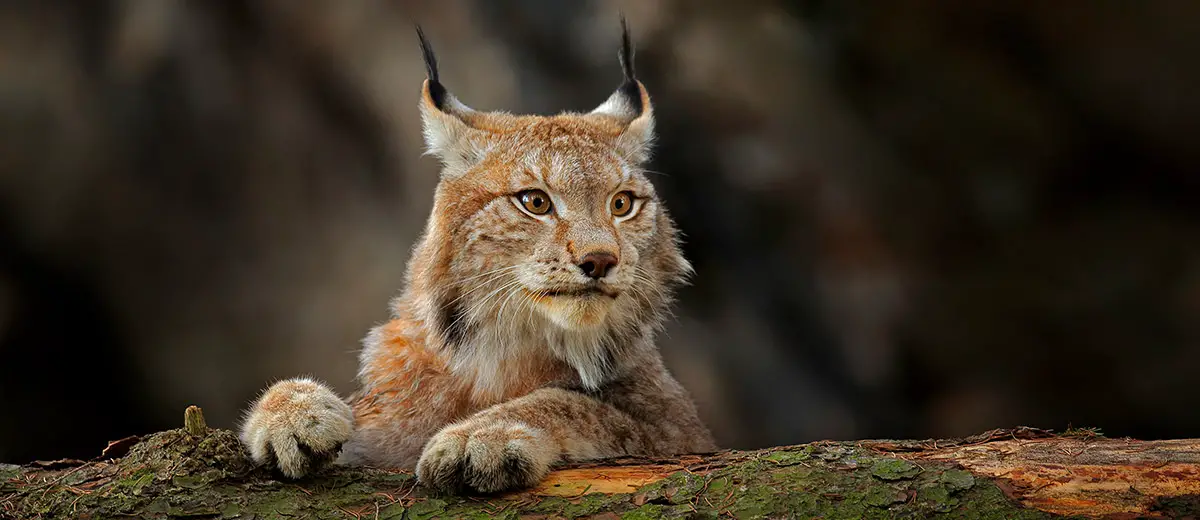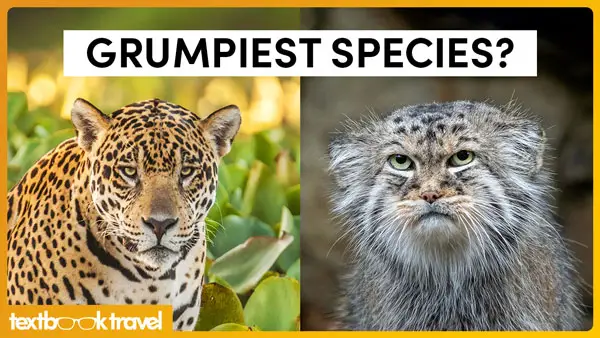All 40 Species of Wild Cats Organised by Lineage (70+ Photos)
The Felidae family contains 40 species of wild cat and one additional species: the much-loved domesticated cat. The classification of wild cats is not only an interesting topic thanks to their wide variety of physical characteristics but is also one of the easiest stories of evolution to follow in the animal kingdom. The oldest split between all remaining extant species of cat occurred more than 10 million years ago when Pantherinae—containing the “Big 5”—split from Felinae—containing the rest of the felids. The Felinae subfamily then continued to diverge until around 1-3 million years ago, producing, among others, the Caracal, Ocelot, Lynx, Puma & Domestic Cat lineages. In this guide, we’ll explore each split in the Felidae family and the lineages and species these evolutionary divergences produced.
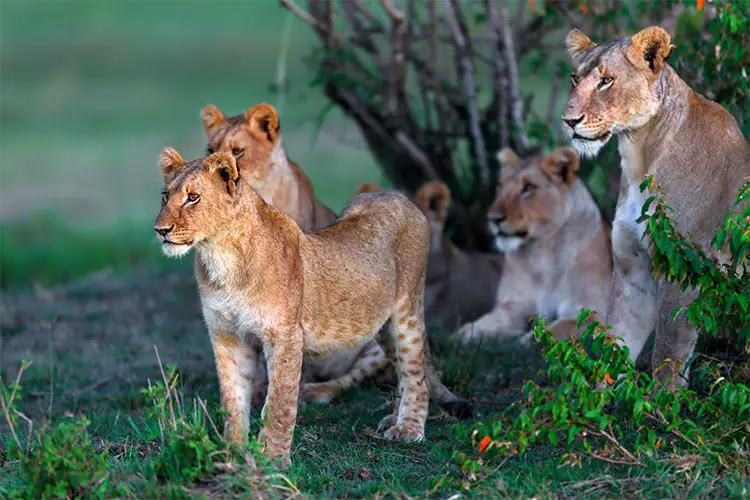
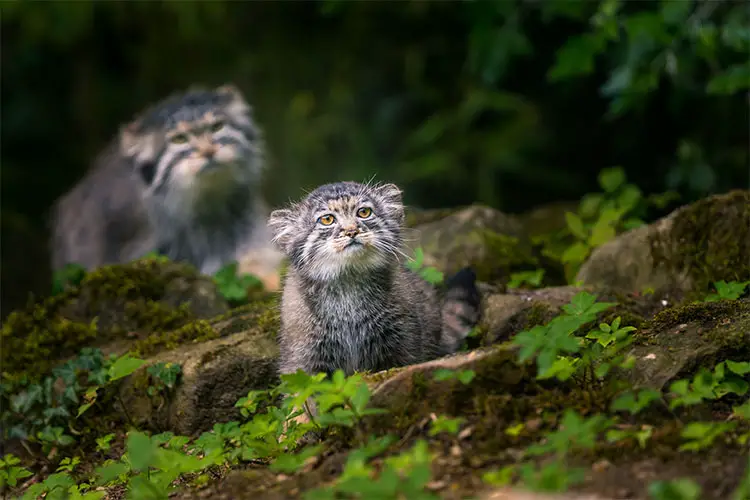
Left – lion pride in Masai Mara, Kenya | Right – Pallas’s cat mother and kitten
Contents
- Panthera Lineage (inc. The Big Five: Lions, Tigers & Jaguars)
- Bay Cat Lineage (inc. Asian Golden Cat & Marbled Cat)
- Caracal Lineage (inc. African Golden Cat & Serval)
- Ocelot Lineage (inc. Oncilla & Margay)
- Lynx Lineage (inc. Eurasian Lynx & Bobcat)
- Puma Lineage (inc. Cougar & Cheetah)
- Leopard Cat Lineage (inc. Pallas’s Cat & Leopard Cat)
- Domestic Cat Lineage (inc. Chinese Desert Cat & European Wildcat)
Panthera Lineage > Panthera & Neofelis Genera > 7 Species
Once upon a time, the earth was roamed by gigantic sabre-tooth tigers. Unfortunately, the last of this no-doubt spectacular subfamily of cats were driven to extinction around 10,000 years ago, leaving behind the remaining extant members of the cat family with the Panthera Lineage—technically known as Pantherinae—containing the largest and most terrifying cats! This subfamily contains two genera: Panthera and Neofelis. Panthera is by far the most famous of all feline genera, holding the “big 5”: tigers, lions, jaguars, leopards and the elusive snow leopard. Neofelis contains two species, both of which are variations of the clouded leopard and are significantly smaller than their distant Pantherinian cousins.
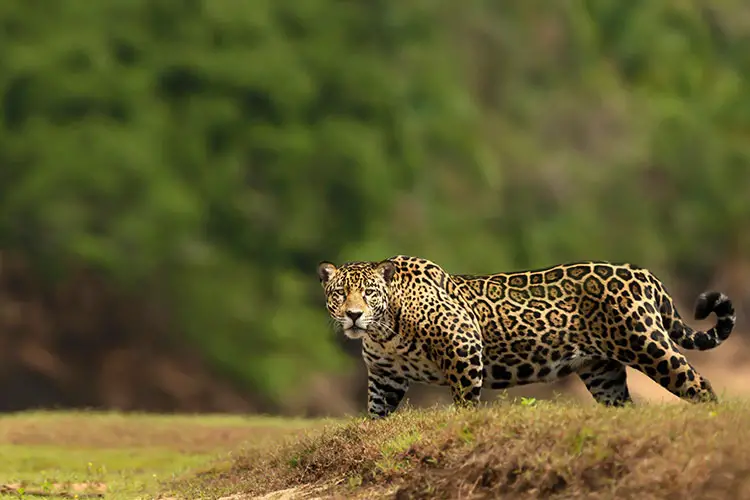
Tiger
The tiger is the largest cat on the planet, measuring up to 3.9m / 13ft in length and weighing up to 300kg / 660lbs. This species is split into 6 subspecies including the Bengal, Malayan and Siberian tiger with an additional 3 subspecies driven to extinction including the Javan and Caspian tiger. They are unique in their appearance, exhibiting an orange coat with black stripes and a white underbelly, tail and facial highlights.
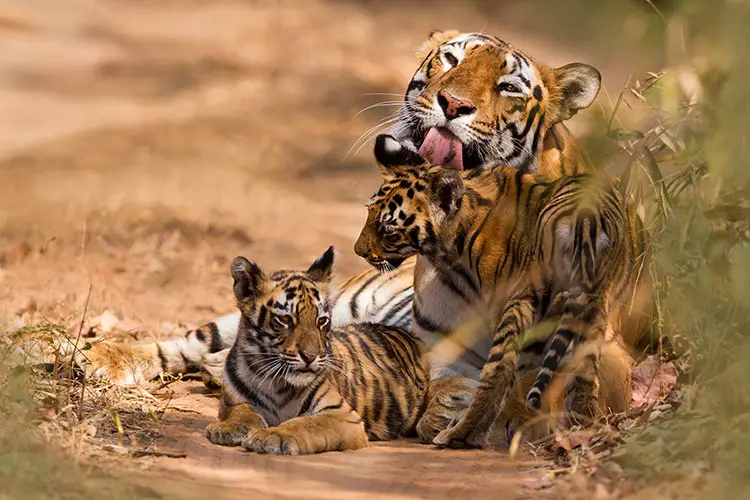
Both black and white tigers have been known to occur from pseudo-melanism and albinism respectively (we’ll talk more about melanism later). They are found mainly in the forests of south and east Asia, with a small population—the aforementioned Siberian tiger—inhabiting the mountain ranges of far-eastern Russia and northern China. Unfortunately, tigers are currently endangered due to poaching and habitat destruction but a healthy population does reside in India where they are protected.
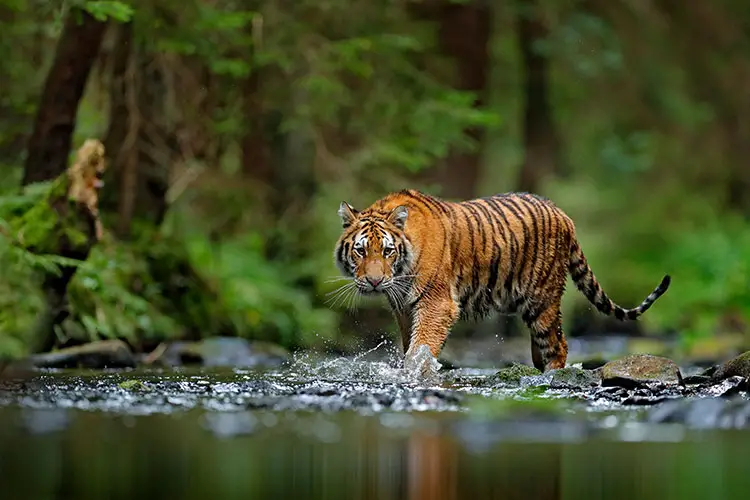
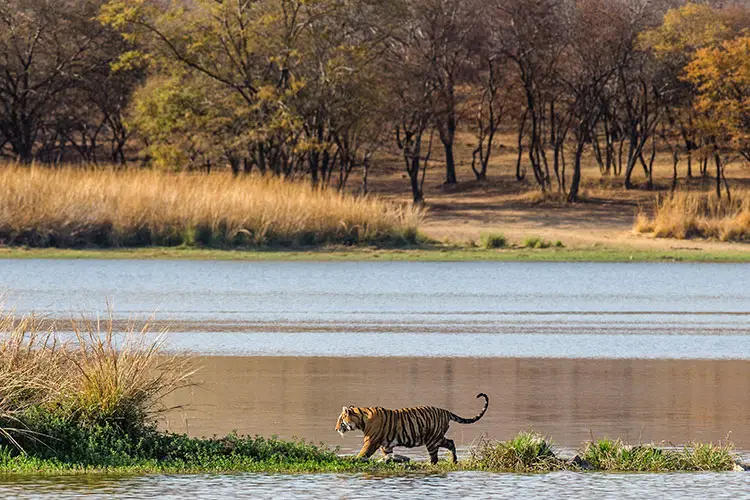
Left – Amur Tiger in Taiga, Russia | Right – Bengal tiger in Ranthambore National Park, India
Tiger Facts
- Defining characteristics – The largest cat on earth & the only cat with bright orange fur
- Max size – 3.9m / 13ft in length (including tail) and 300kg / 660lbs
- Average Lifespan in the wild – 8-10 years
- Activity pattern – Active in the day but usually hunts by night
- Social behaviour – Solitary with a large territorial range
- Habitat – Many different kinds of forest & grassland
- Range – South, east and southeast Asia & far eastern Russia/China
- Prey – Deer, wild cattle & pigs (will eat other cats and bears too)
- Threats/Predators – Humans & occasionally bears
- Conservation status – Endangered (3000-4000 remain)
Snow Leopard
The smallest of the Panthera genus, it makes sense to assume that snow leopards diverged from regular leopards to create a super snow-specializing species! But recent studies have shown that they diverged from tigers and that lions are actually more closely related to leopards. These famously elusive creatures are found on the Tibetan Plateau—the highest mountain range on earth—and regions further north in Mongolia and Siberia.
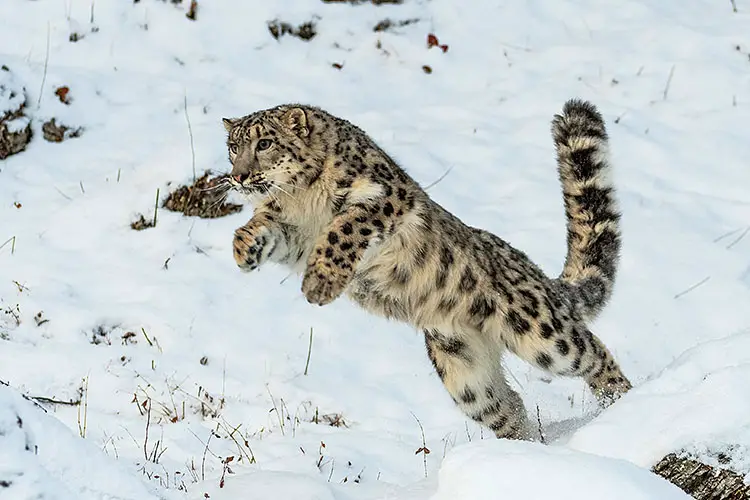
Snow leopards vary the altitude at which they live depending on the season, retreating to higher elevations in the summer where the temperature remains cool. Their thick rusty-white black-spotted fur helps keep them warm in their snowy habitat and provides much-needed camouflage when hunting. There are currently no known subspecies of the snow leopard presumably because of its limited range.
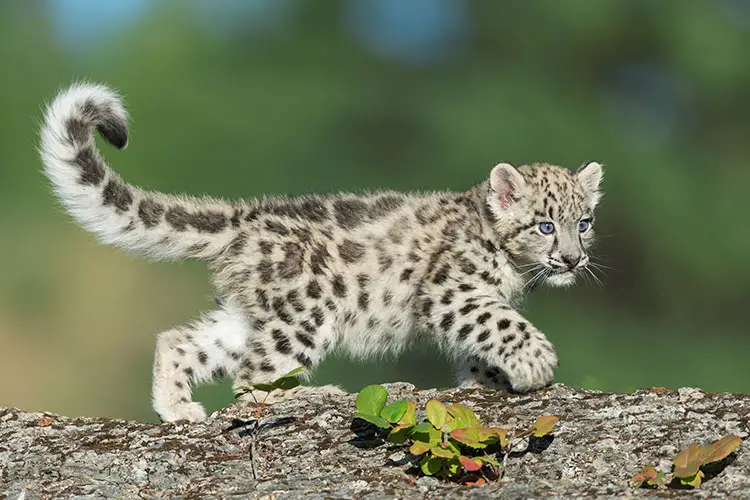
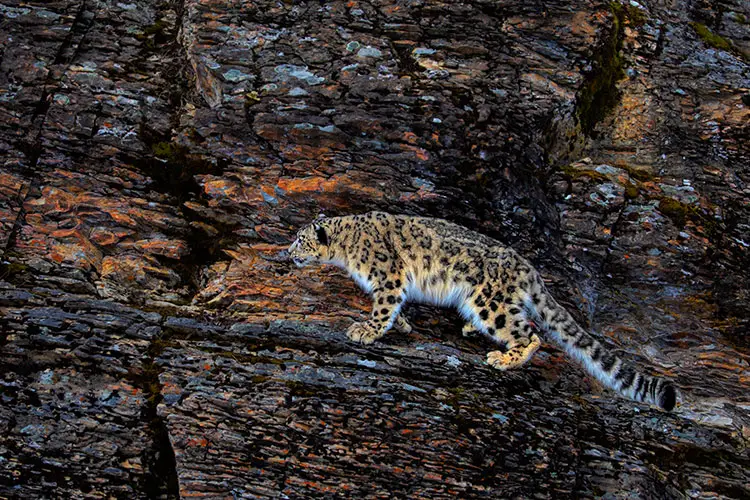
Snow leopard cub & adult snow leopard traversing rocky terrain
Snow Leopard Facts
- Defining characteristics – Thick soft white/grey/black coat
- Max size – 2.1m / 7ft in length (including tail) and 75kg / 165lbs
- Activity pattern – Active mostly during the morning & evening
- Social behaviour – Solitary but will hunt as a mating pair
- Habitat – High-altitude mountainous regions
- Range – The mountain ranges of Central Asia
- Prey – Mountain sheep, deer, goats & smaller mammals such as marmots
- Threats/Predators – Humans & occasionally wolves
- Conservation status – Vulnerable (2,500 – 10,000 remain)
Lion
Lions once roamed the forests of southern Europe and the Middle East but are now restricted to sub-Saharan Africa and a very small population in India. Unlike most other cats who live a solitary existence, lions are pack animals and congregate in prides, which is advantageous for taking down larger prey. Lions also have a unique appearance being the only cat to sport a mane; Charles Darwin postulated that the mane of a male lion developed through natural selection as a means of protection while fighting other males as well as an intimidation tactic.
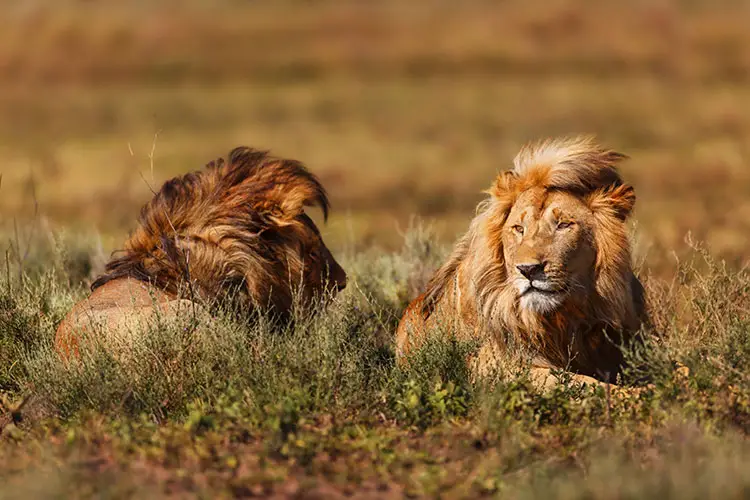
The mane of a male lion has also been shown to be a factor for females when choosing a mate with darker and thicker manes being the most popular hairstyle. Being a plain yellowish-brown colour, the lion’s coat is the least decorated of all the big cats, however, they do have a fancy black tuft on the end of their tail which no other feline has! The white lion is a rare colour variation caused by a genetic condition called leucism, which results in a loss of pigmentation.
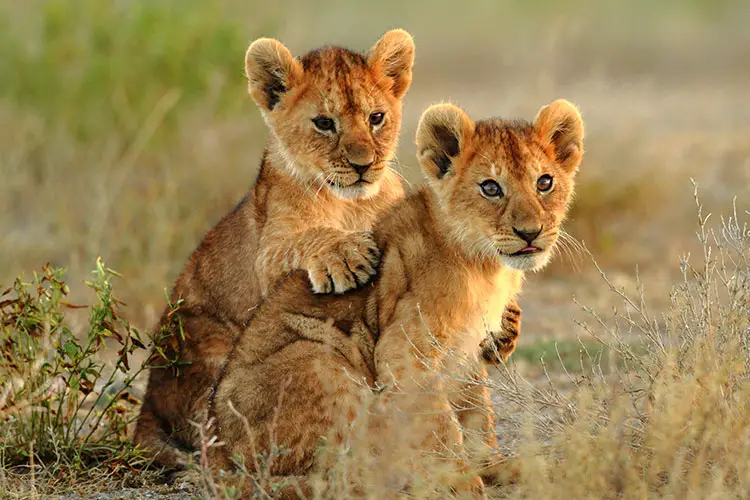
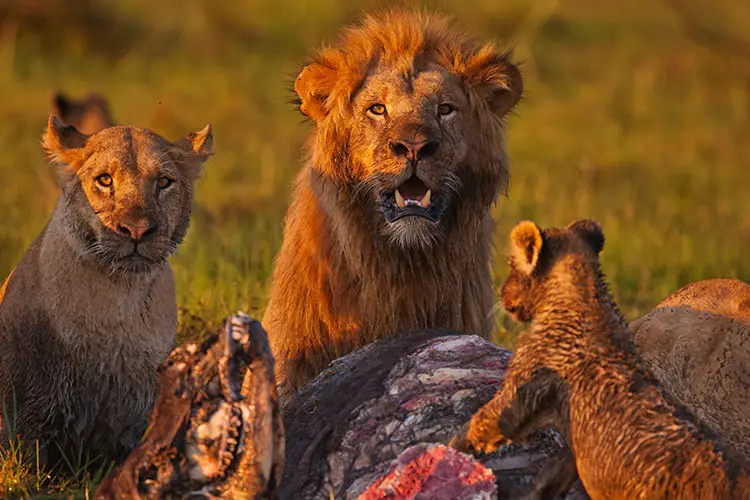
Left – Lion Cubs in Kruger National Park, South Africa | Right – Lion pride feasting on kill in Tanzania
Lion Facts
- Defining characteristics – A tuft at the end of their tail and males have a mane
- Max size – 3m / 12ft (including tail) & 250kg / 550lbs
- Average Lifespan in the wild – 15 years
- Activity pattern – Spend up to 20 hours a day relaxing. Most active at night/dawn
- Social behaviour – The most social of all cats, hang out in prides of up to 30 lions
- Habitat – Grasslands & savannas
- Range – Sub-Saharan Africa & a small population in India
- Prey – Wildebeest, zebra, buffalo, deer and many other animals
- Threats/Predators – Humans, crocs, hyenas (some herd animals for self-preservation)
- Conservation status – Vulnerable (roughly 20,000 left)
Leopard
In Africa, Leopards occupy a similar territory to lions but they are also found throughout much of Asia as well. Male leopards can weigh up to 90kg / 200lbs and although they are significantly smaller than both lions and tigers, they are famously agile and can hunt while leaping from tree to tree. The pattern of their fur is similar to that of a jaguar but their black rosettes tend to be smaller and less intricate.
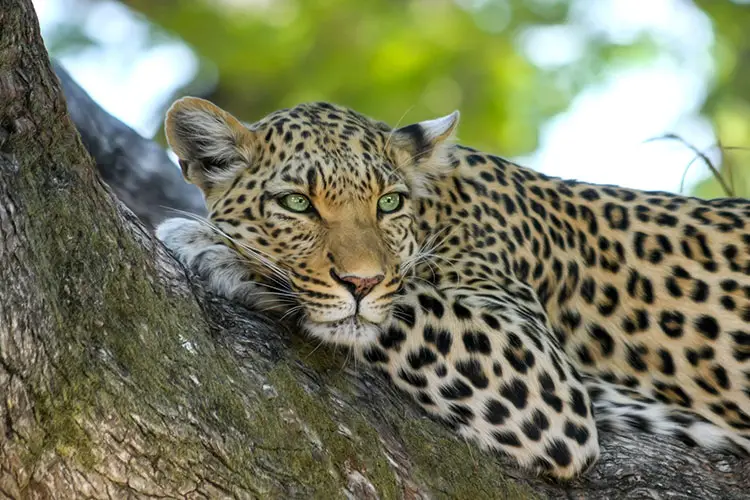
One of the most famous colour variations is the black panther, which is not a separate species; excessive production of Melanin causes the black pigmentation of fur and although there are black panthers in Africa the most common occurrence of this variant is found on the Malay Peninsula. There are 27 subspecies of leopard making it one of the most geographically and visually varied felines; some subspecies such as the Indian leopard are noticeably more orange than their African counterparts.
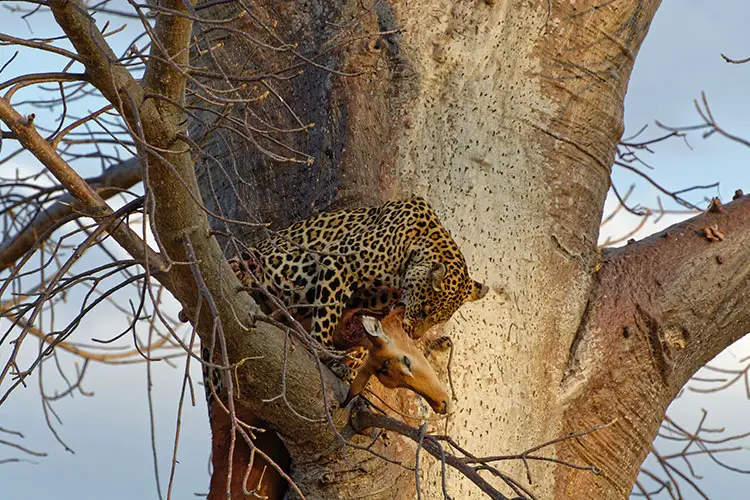
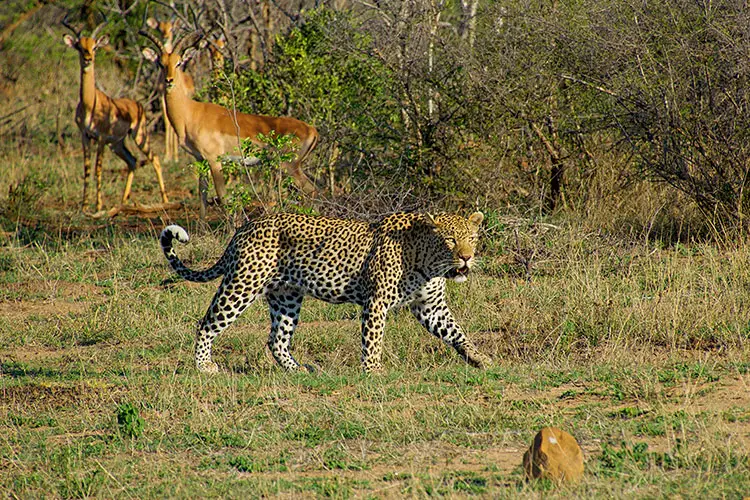
Left – Leopard with a kill in Maasai Mara, Kenya Unsplash: Colin Watts | Right – Leopard hunting impala in Kruger National Park, South Africa Unsplash: Joss Woodhead
Leopard Facts
- Defining characteristics – Black rosettes, generally with no inner spots
- Max size – 3m / 12ft (including tail) & 90kg / 200lbs
- Average Lifespan in the wild – 10-12 years
- Activity pattern – Hunts at night but can vary between season, habitat and prey
- Social behaviour – Solitary and territorial but ranges can overlap
- Habitat – Varied; forest, savannah, grassland, woodland
- Range – Sub-saharan Africa & central/east Asia
- Prey – Antelope, deer, warthogs (small to medium-sized mammals)
- Threats/Predators – Larger cats, hyenas, wolves, bears & humans
- Conservation status – Vulnerable (unknown but likely less than 100,000)
Jaguar
Jaguars are commonly mistaken for Leopards due to their visually similar fur pattern, however, there are several distinct differences between the two species. Unlike the African/Asian dwelling Leopard, Jaguars are found throughout Central and South America and these aquatically inclined felines can be up to twice the size—males can weigh just under 160kg / 350lbs!
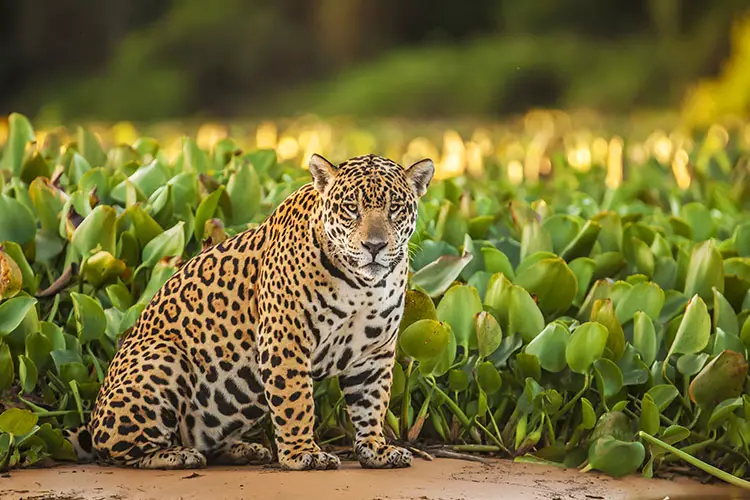
Their fur pattern also differs slightly with spots inside each black rosette and they can also be subject to Melanism, producing entirely back Jaguars—this also leads to the confusion between species. They have adapted to living in the wet rainforests and wetlands of South America including and especially the Amazon rainforest. This has made Jaguars excellent swimmers; they consume more reptiles than any other cat, using their powerful bite and large canines to prey on turtles and caiman. Jaguars are a monotypic species meaning that there are no currently defined subspecies.
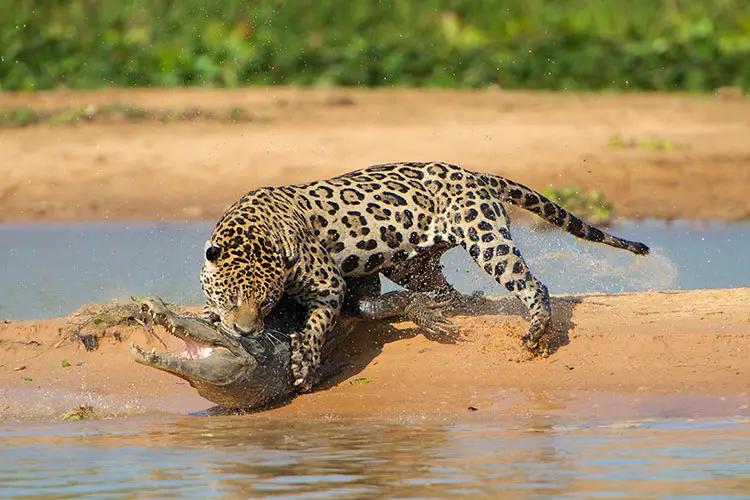
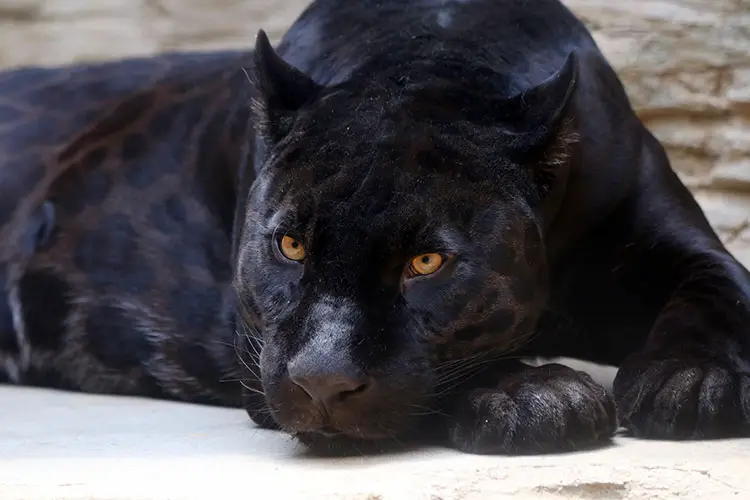
Left – Jaguar attacking caiman in the Pantanal, Brazil | Right – Black jaguar aka black panther with visible melanism Pixabay: Katerina Vulcova
Jaguar Facts
- Defining characteristics – Spots on the inside of their rosettes (some appear grumpy!)
- Max size – 2.7m / 9ft (including tail) & 160kg / 350lbs
- Average Lifespan in the wild – 11-12 years
- Activity pattern – Hunt mainly at night but also active during the day
- Social behaviour – Solitary and territorial
- Habitat – All kinds of forests and wetlands/grasslands
- Range – Central and South America
- Prey – Deer, capybara, birds, fish, turtles, caiman & livestock
- Threats/Predators – Humans (pretty much just us, sadly)
- Conservation status – Near Threatened (64,000 remain)
Clouded Leopard
The first of two species contained in the Neofelis genus, the clouded leopard is significantly smaller—males can weigh up to 23kg / 50lbs—and are found throughout much of east and southeast Asia. Their fur pattern reminds me a little bit of a python, with its dark brown-green fur camouflaged with a large black-spotted pattern. Melanism can also occur in clouded leopards although it is rare. They are solitary animals who are arboreal—living mostly in the trees—and hunt at night due to overlapping ranges with tigers and leopards.
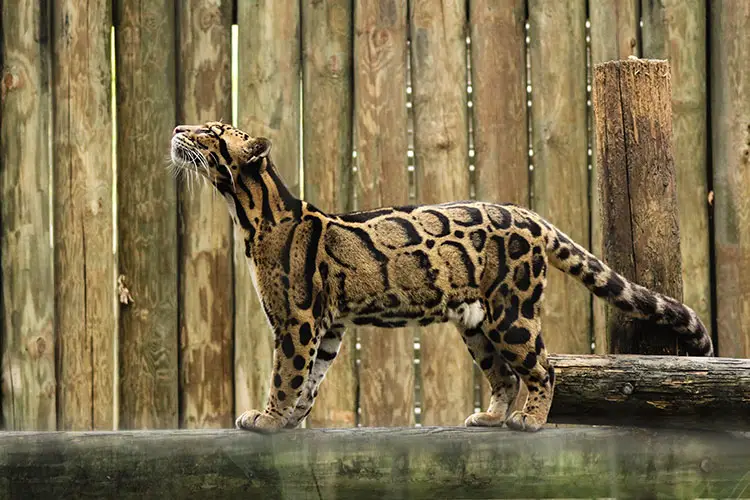
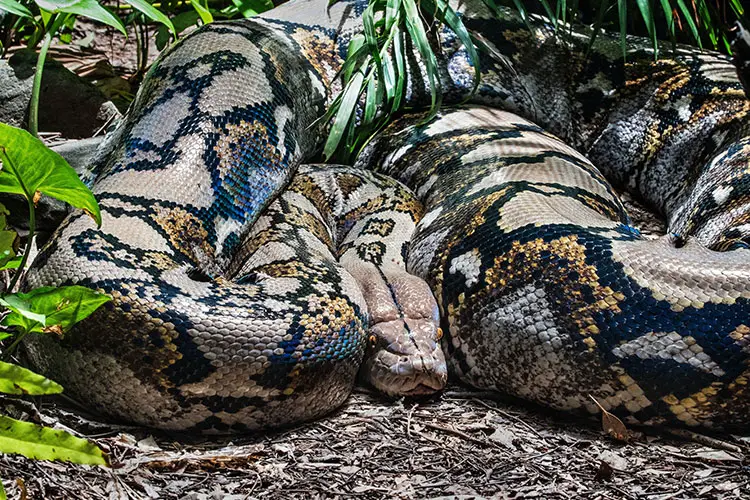
See, they’re quite similar! Left – Clouded leopard | Right – Reticulated python Unsplash: David Clode
Clouded Leopard Facts
- Defining characteristics – Unique large black markings
- Max size – 2m / 6ft (including tail) & 23kg / 50lbs
- Average Lifespan in the wild – 11 years
- Activity pattern – Nocturnal & arboreal
- Social behaviour – Solitary
- Habitat – Woodlands & forests
- Range – East and Southeast Asia
- Prey – Monkeys, deer, squirrels, birds
- Threats/Predators – Larger cats & humans
- Conservation Status – Vulnerable (less and 10,000 remain)
Sunda Clouded Leopard
This distinct species of cat diverged from the clouded leopard around 1-2 million years ago and is found exclusively on the islands of Borneo and Sumatra. Visually, it is very similar to the clouded leopard except for a slightly darker fur. One of the largest recorded populations of the Sunda clouded leopard is in Sabah—a northern state of Borneo—which is also home to orangutans, the Asiatic black bear and the bay cat.
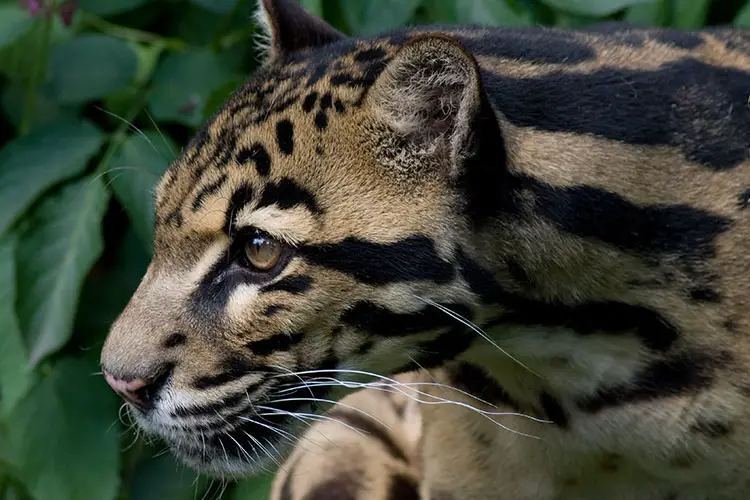
Sunda Clouded Leopard Facts
- Defining characteristics – Slightly darker and larger than the regular clouded leopard
- Max size – 2m / 6ft (including tail) & 30kg / 66lbs
- Activity pattern – Nocturnal & arboreal
- Social behaviour – Solitary
- Habitat – Primarily forests
- Range – Borneo & Sumatra
- Prey – Deer, palm civet, monkeys, squirrels, birds
- Threats/Predators – Larger cats & humans
- Conservation Status – Vulnerable
Bay Cat Lineage | Catopuma & Pardofelis Genera | 3 Species
Catopuma & Pardofelis were the first genera to diverge from the Felinae subfamily and split from each other around 9.4 million years ago. This lineage has a very similar range to the clouded leopard—occupying the forests of east and southeast Asia—and contains only three distinct species. Both the Asian golden cat and the marbled cat are similar in appearance to some of their relatives but the bay cat is one of the most unique felines I have come across.
Bay Cat
This rather odd-looking cat (I’m sorry but it is!) exhibits a long bushy tail and either grey or a vibrant chestnut coat—the most common variant. They are endemic to Borneo and are listed as endangered with only around 2,500 left in the wild. With such a small sample size it is difficult to determine an accurate estimation of their weight and size but experts say this species weighs no more than 4kg / 9lbs and can grow up to around 50-65cm / 19.5-26.4 inches in length.
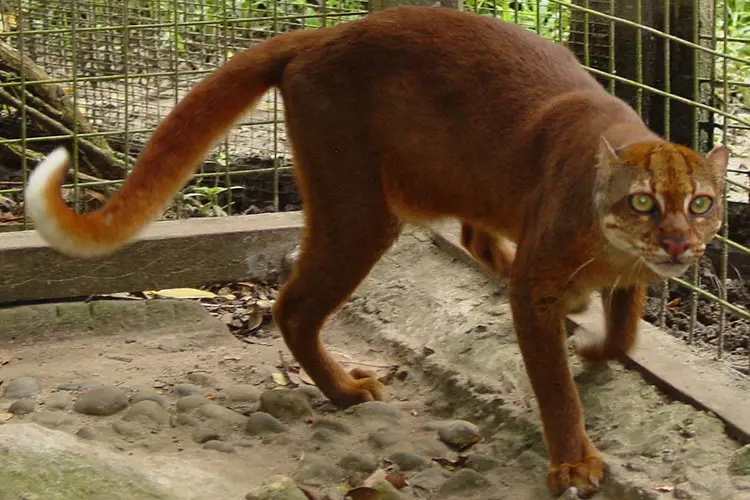
Bay Cat Facts
- Defining characteristics – Chestnut-coloured coat
- Max size – 1m / 3ft (including tail) & 4kg / 9lbs
- Activity pattern – Nocturnal
- Habitat – Forests
- Range – Borneo
- Threats/Predators – Humans (deforestation and poaching)
- Conservation status – Endangered (2,500 remain)
Asian Golden Cat
This particularly beautiful cat is another feline found throughout south, east and southeast Asia. They have been observed with a variety of fur colours with some exhibiting a lighter reddish coat and others with a darker brownish coat. Asian Golden Cats are adept at climbing trees in the forests they inhabit and have been shown to be a mixture of diurnal and crepuscular—active during twilight—hunting mostly small mammals and birds.
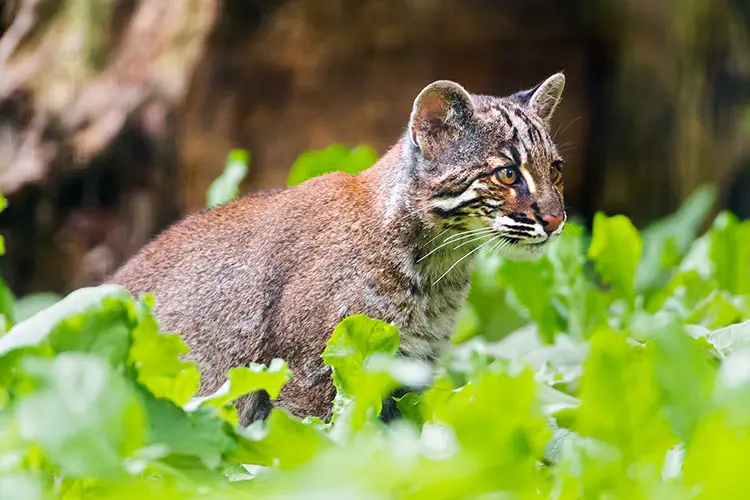
Asian Golden Cat Facts
- Defining characteristics – Reddish coat with beautiful marbled face
- Max size – 1.6m / 5ft (including tail) & 16kg / 35lbs
- Activity pattern – Diurnal and crepuscular
- Social behaviour – Solitary & territorial
- Habitat – Different types of forest
- Range – East and southeast Asia
- Prey – Rodents, birds, reptiles and small deer
- Threats/Predators – Humans
- Conservation status – Near Threatened
Marbled Cat
The smallest member of the bay cat lineage, the marbled cat has more or less the same range and has a very similar colouring to a clouded leopard; the main fur colour has a browny-green hue camouflaged with a black-spotted pattern. They are thought to be semi-arboreal and roughly the same size as a domesticated cat.

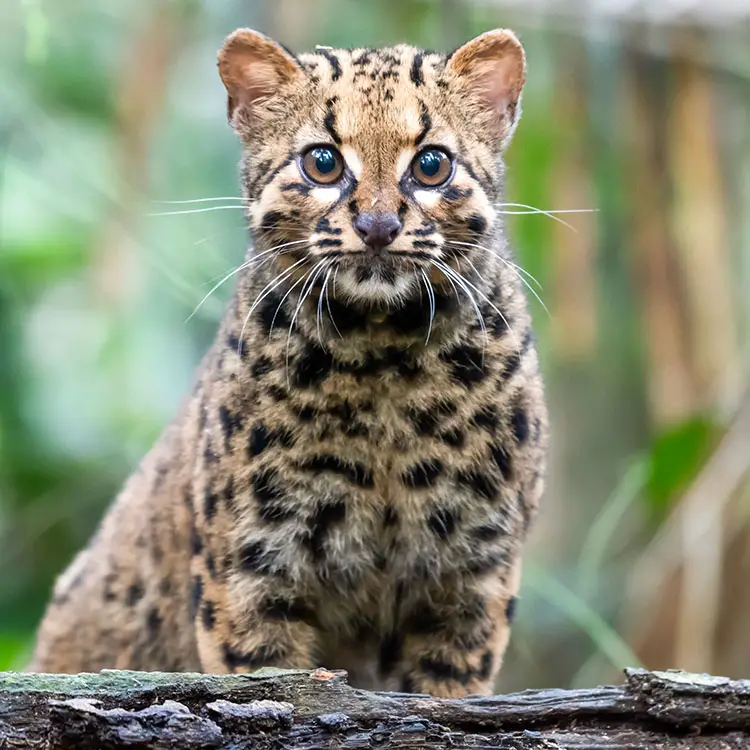
Left – Marbled Cat in Danum Valley Conservation Area, Borneo WikiCommons: Johan Embréus | Right – Marbled Cat in Thailand
Marbled Cat Facts
- Defining characteristics – A mini clouded leopard!
- Max size – 1.2m / 4ft (including 55cm tail) & 5kg / 11lbs
- Activity pattern – Active during the day but will hunt at night too
- Social behaviour – Solitary
- Habitat – Different types of forest
- Range – South and southeast Asia
- Prey – Birds, squirrels, rats, mice, bats
- Threats/Predators – Humans
- Conservation status – Near Threatened (around 10,000 remain)
Caracal Lineage | Caracal & Leptailurus Genera | 3 Species
Somewhere around 5.4 million years ago, the caracal lineage was the next group of felids to diverge from the main pack. These cats and are mainly found in Africa, although the Caracal has a range as far west as India. The caracal lineage contains two genera; Leptailurus contains a single species, the serval, while the caracal genus is split between the caracal and the African golden cat.
Caracal
The caracal is the only species from this lineage to be found in Asia, with a range extending as far east as India and as far north as Turkmenistan. In my opinion, the caracal is similar in appearance to a cougar with a reddish-brown fur and no camouflaging. They also exhibit tufts of hair on the tops of their ears; they have been observed using them to communicate by bobbing their heads from side to side (try picturing that!).
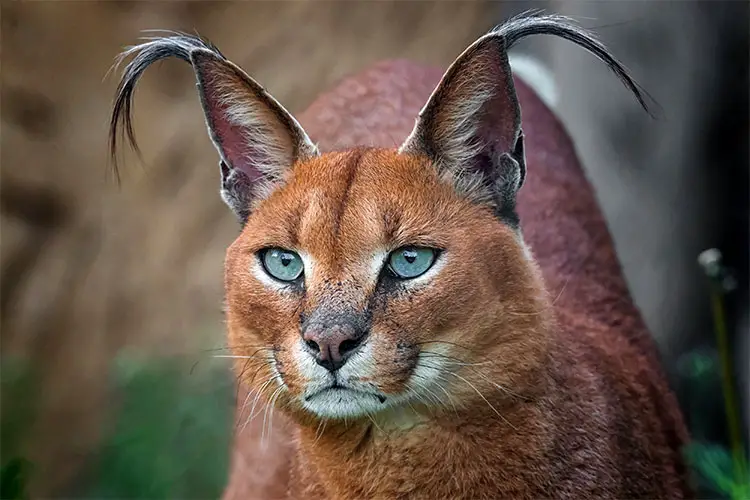
They are famously agile and have been known to perform impressive gymnastic-like stunts while catching birds in mid flight. The caracal is also known as the Desert Lynx or Persian Lynx and can be found throughout much of the Middle East.
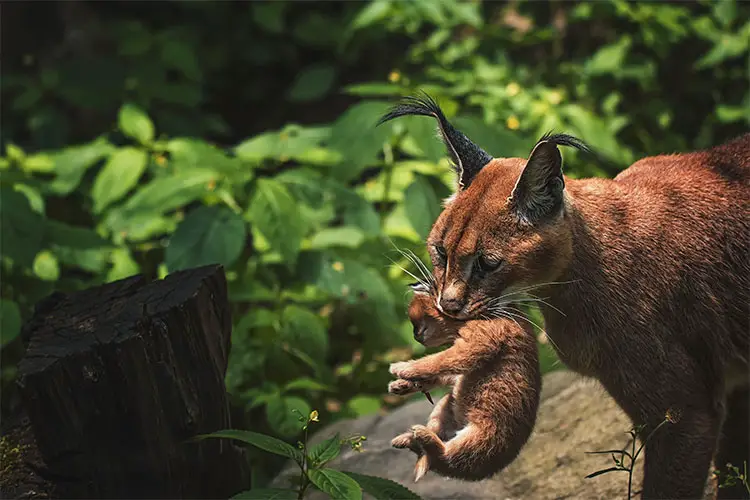
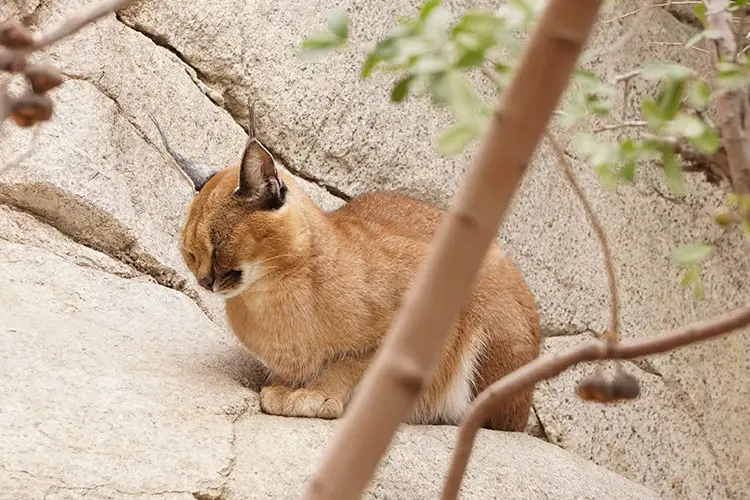
Left – Caracal mother with small cub | Right – Caracal taking a cat-nap! Pixabay: sharonjoy17
Caracal Facts
- Defining characteristics – Mini cougar with black tufts on ears
- Max size – 1.4m / 4ft (including tail) & 19kg / 42lbs
- Average Lifespan in the wild – 12 years
- Activity pattern – Mostly nocturnal but also active during the day
- Social behaviour – Solitary and territorial
- Habitat – Forests, savannah & semi-desert
- Range – Africa, the Middle East & south Asia
- Prey – Small mammals, birds and rodents
- Threats/Predators – Larger cats, hyenas & humans
- Conservation status – Least Concern (finally!)
African Golden Cat
The other member of the caracal genus is the African golden cat. As the name suggests, these felines are found solely in Africa and, when compared to other cat species, occupy quite a small range in the rainforests of central and west Africa. They are mostly golden in colour, although some have been observed with a grey coat, and spotted markings are present on some of these cats on the underside of their belly and the backs of their legs. They hunt mostly on the ground but are good hunters and have been known to climb a tree or two to snatch a monkey or a bird!
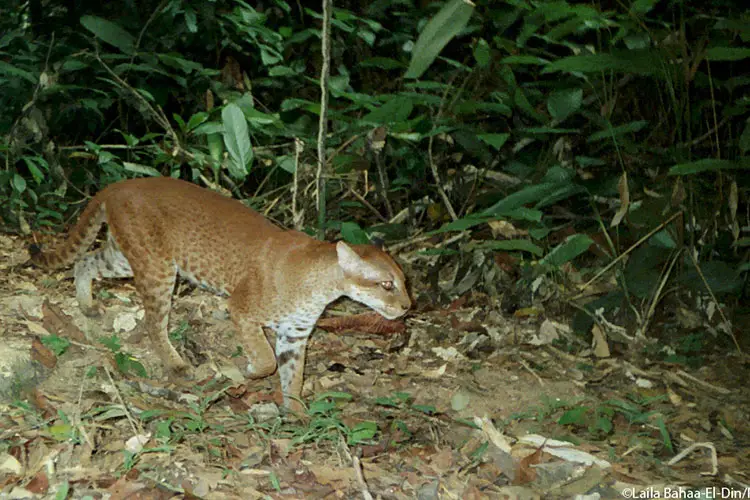
African Golden Cat Facts
- Defining characteristics – Golden coat with spots on the belly
- Max size – 1.5m / 4ft (including 46cm tail) & 16kg / 35lbs
- Activity pattern – Mostly nocturnal or crepuscular
- Social behaviour – Solitary
- Habitat – Mainly tropical forests
- Range – Equatorial Africa
- Prey – Smaller mammals such as antelope and monkeys, birds and fish
- Threats/Predators – Leopards
- Conservation status – Vulnerable
Serval
Servals have a particularly unique appearance; they look like a cross between a cheetah and a maned wolf (I’m sorry for these weird analogies, I’ll provide photos, you’ll see what I mean!). They have light yellowish fur with black spots and stripes and have a particularly short tail and large ears. These slender animals—who have the longest legs of all cats relative to body size—are no more than 100cm / 39 inches in length and weigh up to 18kg / 40lbs. A small population exists in Morocco but these cats live mostly in Sub-Saharan Africa where they prey on rodents, birds and reptiles in addition to eating grass to aid with digestion.
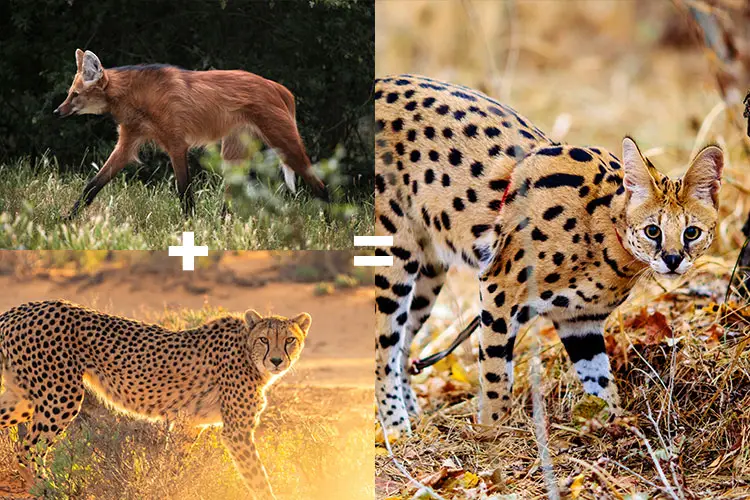
Serval Facts
- Defining characteristics – Mini cheetah with large stripy ears
- Max size – 1.3m / 4ft (including 30cm tail) & 18kg / 40lbs
- Average Lifespan in the wild – 10 years
- Activity pattern – Hunt in early morning/late afternoon (occasionally at night)
- Social behaviour – Solitary and territorial
- Habitat – Savanna, wetlands, grasslands and forests
- Range – Most of sub-Saharan Africa
- Prey – Rodents, birds, reptiles and insects
- Threats/Predators – Humans and occasionally leopards and hyenas
- Conservation status – Least Concern
Ocelot Lineage | Leopardus Genus | 8 Species
The ocelot lineage contains only one genus, Leopardus and is one of the most diverse lineages, containing 8 species of cat, all living in Central & South America. With the exception of the Pampas cat, whose markings are much less pronounced, the cats in this genus have similar markings to a jaguar with black rosettes atop a light-brown and white fur. With the exception of the ocelot, all of these cats are thought of as “small” cats, weighing no more than around 4kg / 9lbs.
Ocelot
This is by far my favourite cat in this lineage, its markings are made up of clear and distinct black spots and streaks atop a yellowish-brown and white body. Weighing up to 15.5kg / 34lbs, its size, the shape of its head, and its poise are more similar to that of a jaguar—although their colour/markings are not the same.
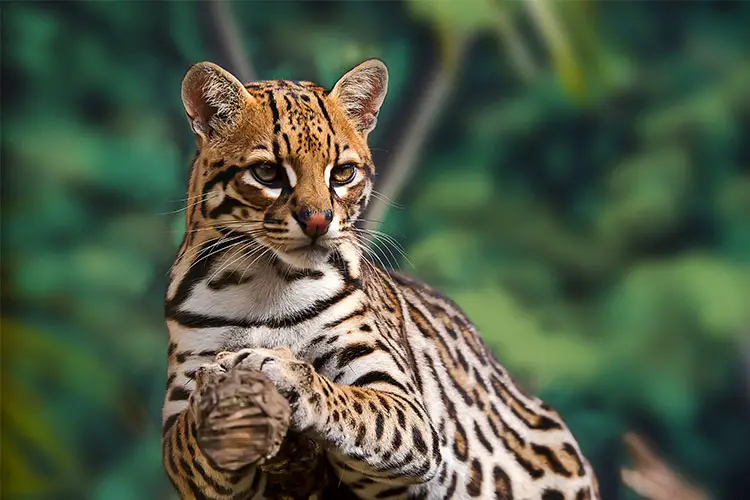
Interestingly, the word “ocelot” derives from a Uto-Aztec language called Nahuatl, which means Jaguar, possibly named so due to its similarity in appearance. The ocelot has a large range from the mountain ranges of eastern Mexico all the way down to the rainforests of Brazil. Thankfully, their conservation status is set to least concern.
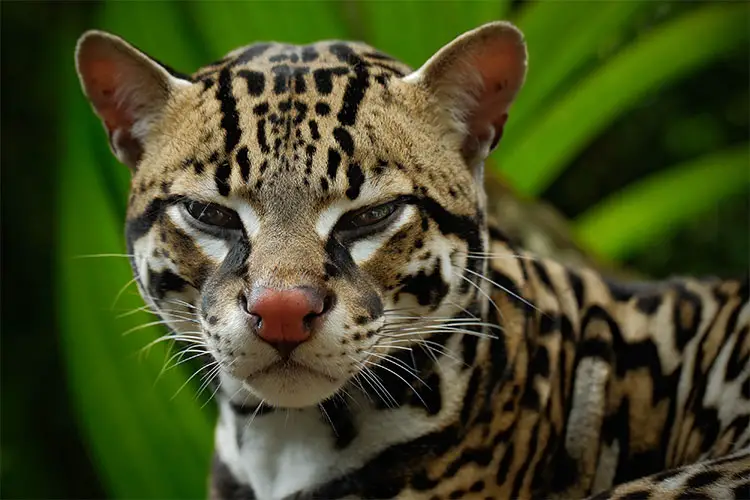
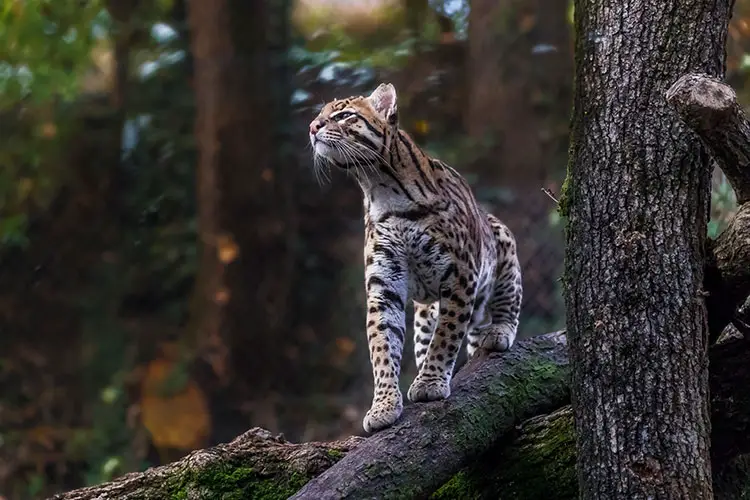
Left – Ocelot close up & Right – Posing on tree branch
Ocelot Facts
- Defining characteristics – Stubby muzzle and beautiful markings
- Max size – 1.5m / 4.5ft (including 45cm tail) & 15.5kg / 34lbs
- Average Lifespan in the wild – 7 to 10 years
- Activity pattern – Mostly nocturnal or crepuscular
- Social behaviour – Solitary and territorial
- Habitat – Forests, savanna and mangrove swamps
- Range – Central and South America
- Prey – Small mammals, rodents, fish, insects and small birds
- Threats/Predators – Harpy eagles, larger cats and anacondas
- Conservation status – Least Concern
Margay
Margays are much smaller than ocelots but are often confused for this species. They too have a combination of black spots and streaks atop a light brown fur but their size and appearance is much more similar to that of a domestic cat than that of a large jaguar. These famously agile cats—often referred to as tree ocelots—can leap from tree to tree where they chase monkeys, birds and small reptiles. The margay has a very similar range to the ocelot with the exception of far western Peru.
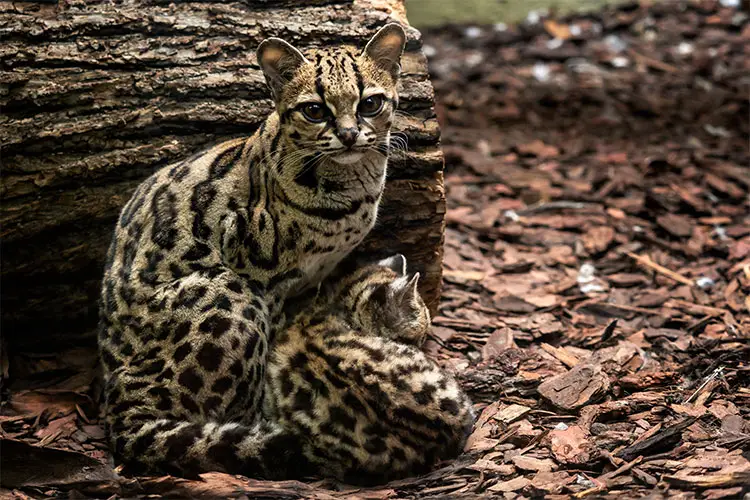
Margay Facts
- Defining characteristics – A miniature ocelot!
- Max size – 1.3m / 4ft (including 50cm tail) & 4kg / 8.8lbs
- Activity pattern – Active during both day and night
- Social behaviour – Solitary
- Habitat – Tropical evergreen & dry forest and cloud forest
- Range – Central and South America
- Prey – Small mammals, birds, amphibians, reptiles and fruit
- Conservation status – Near Threatened
Oncilla (Northern Tiger Cat)
The oncilla is another species often confused for the margay or the ocelot thanks to its similar markings. If the margay was a mini ocelot, the oncilla would be a mini margay! Weighing up to 3kg / 6.6lbs, this species also spends a lot of time in the trees hunting for small rodents, birds and other small animals. Its range is mostly restricted to northern South America, however, a small population also exists in Costa Rica and Panama. The oncilla’s conservation status is currently listed as vulnerable.
Southern Tiger Cat
In 2013 It was discovered that there were in fact two populations of oncilla who didn’t interbreed, creating two separate species named the Northern & Southern Tiger Cat. Visually, it is difficult to distinguish between the two species; they are said to have very similar markings to the northern tiger cat but are slightly darker. The range of the southern tiger cat is (unsurprisingly!) south to that of the oncilla, being found mostly in Brazil along with Paraguay and Argentina where they prey on small mammals, birds and lizards.
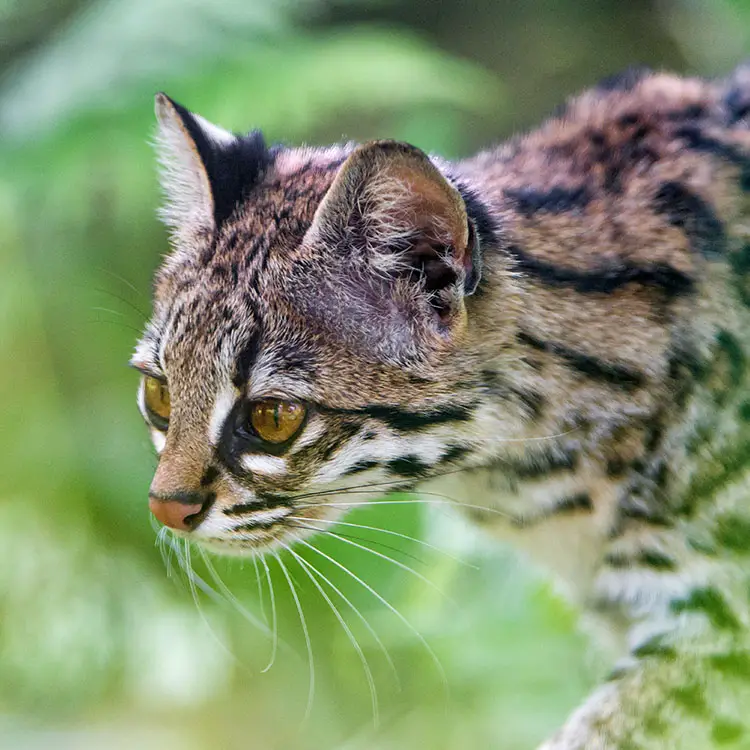
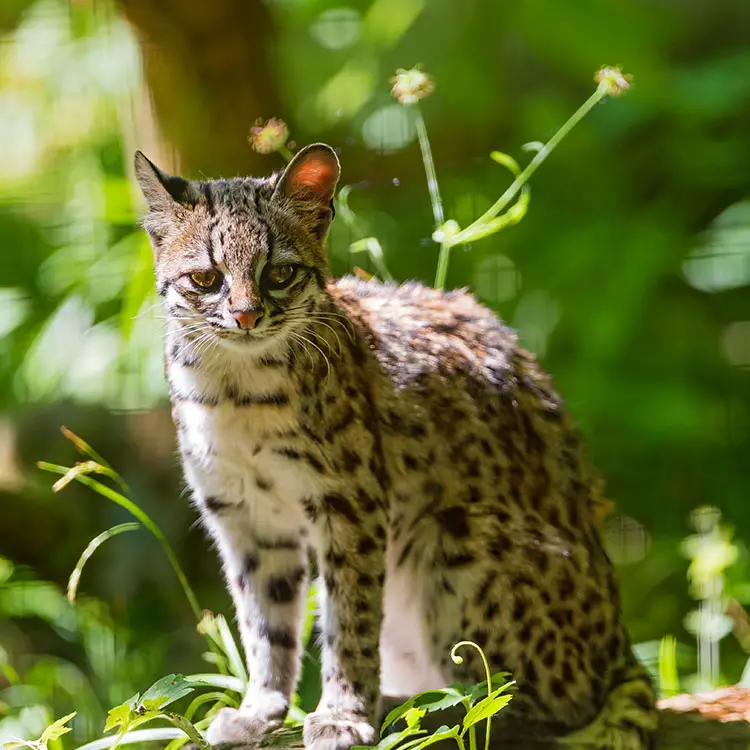
The inquisitive Oncilla | Flickr: Tambako The Jaguar
Oncilla & Southern Tiger Cat Facts
- Defining characteristics – A miniature margay!
- Max size – 1.2m / 3.6ft (including 35cm tail) & 3kg / 6.6lbs
- Average Lifespan in the wild – 11 years
- Activity pattern – Mainly nocturnal but do hunt in the day
- Social behaviour – Solitary
- Habitat – Different forest ecosystems
- Range – Central and South America
- Prey – Small mammals, birds, frogs, lizards
- Conservation status – Vulnerable
Geoffroy’s Cat
Roughly the same size as a Margay, the Geoffroy’s cat is found only in southern South America and is named in honour of the French zoologist, Etienne Geoffroy Saint-Hilaire who died the same year this species was discovered. It has been known to live at altitudes of up to 3,800 meters in the Andes and is particularly prevalent in Bolivia where it is outnumbered only by the ocelot. Interestingly there is also a Melanistic version (a mini black panther!) but I was unable to find a photo of this variation.
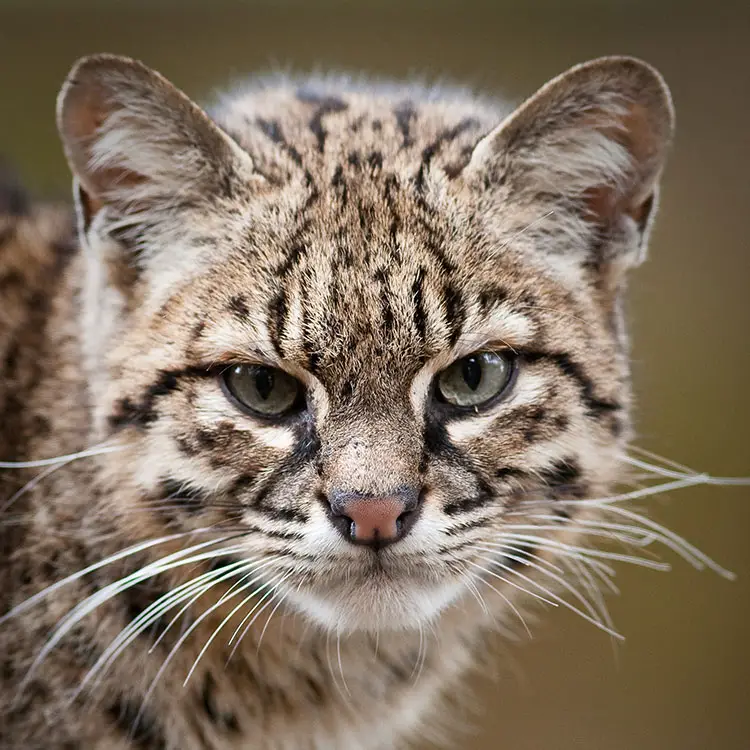
Geoffroy’s cat Facts
- Defining characteristics – Similar to a domestic cat but with big cat markings
- Max size – 90cm / 3ft (including 30cm tail) & 7.8kg / 17lbs
- Activity pattern – Mostly nocturnal
- Social behaviour – Solitary
- Habitat – Grasslands, savannahs, wetlands & forests
- Range – Southern South America
- Prey – Rodents, hares, lizards, insects, frogs and fish
- Threats/Predators – Larger cats, foxes, birds of prey & humans
- Conservation status – Least Concern
Kodkod
The Kodkod is the closest relative to the Geoffroy’s cat and is kind of like its smaller, fluffier cousin! In fact, the Kodkod is the smallest feline in the Americas weighing up to around 3kg / 6.6lbs. It lives in a range of forest biomes including rainforests and deciduous temperate forests and is only found on the far western side of the continent in Chile and Argentina. They are also excellent at climbing trees and won’t venture past the treeline into the alpine.
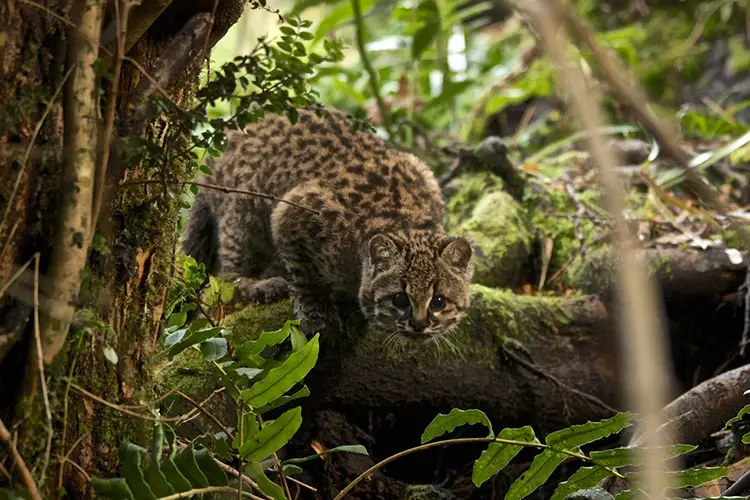
Kodkod Facts
- Defining characteristics – Similar to a Geoffroy’s Cat but fluffier tail
- Max size – 75cm / 30in (including 25cm tail) & 2.5kg / 5.5lbs
- Average Lifespan in the wild – 11 years
- Activity pattern – Can be both nocturnal and diurnal
- Social behaviour – Solitary
- Habitat – Temperate rainforests
- Range – Chile and north-western Argentina
- Prey – Rodents, reptiles, birds and insects
- Threats/Predators – Humans and domestic dogs
- Conservation status – Vulnerable (less than 10,000 remain)
Andean Mountain Cat
I like to think of the Andean mountain cat as a miniature snow leopard! Another small cat, roughly the same size as a Geoffroy’s Cat or a Margay, this alpine-loving feline is found in the Andes Mountain Range in South America and has a much thicker coat than the margay, ocelot or oncilla allowing it to live exclusively at high elevation along with the Pampas Cat and the Puma. Unfortunately, the Andean Mountain Cat is classified as endangered and is the most threatened of all the felines in the Americas. They prey almost entirely on mountain viscacha—rodents with a similar appearance to rabbits.
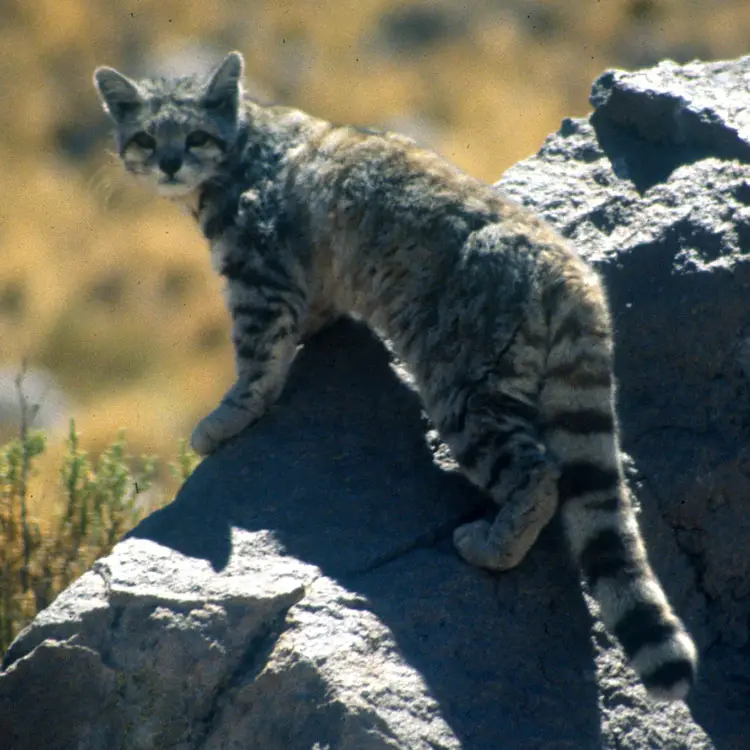
Andean Mountain Cat Facts
- Defining characteristics – A cross between a domestic cat and a snow leopard!
- Max size – 1.3m / 4.5ft (including 1.5ft tail) & 5.5kg / 12lbs
- Activity pattern – Primarily nocturnal
- Social behaviour – Solitary
- Habitat – High-elevation, mountainous terrain
- Range – Andes Mountain Range
- Prey – Almost entirely mountain viscacha (a rodent)
- Threats/Predators – Poached by humans for their fur
- Conservation status – Endangered
Pampas Cat
The Pampas Cat is named after the Pampas lowlands, an area of fertile plains in far southern Brazil and eastern Argentina. However, this species occupies a far wider range than the boundaries of the Pampas from the high alpine in the Andes to the surrounding woodland, swampland and the savannah. This cat has been notoriously hard to categorise with five to seven subspecies and many different variations of fur. They have a very similar diet to the Andean Mountain cat but a little more varied.

Pampas Cat Facts
- Defining characteristics – Wildly varied fur with a bushy tail
- Max size – 1m / 3ft (including 30cm tail) & 4kg
- Average Lifespan in the wild – 9 years
- Activity pattern – Both diurnal and nocturnal depending on location
- Social behaviour – Solitary
- Habitat – Grassland, forests, mountainous terrain and shrubland
- Range – Western South America
- Prey – Mountain viscachas, rodents, guinea pigs and small birds
- Threats/Predators – Dogs and larger cats
- Conservation status – Near Threatened
Lynx Lineage | Lynx Genus | 4 Species
The lynx lineage is one of my favourite cat genera, these beautiful creatures have short tails and shaggy fur and are well-adapted to their typically snowy and/or mountainous environment. The lynx genus is made up for four species, each of which are quite distinct from one another both visually and in terms of habitat with only a small amount of crossover between the Canada Lynx and Bobcat around the Canada/USA border. It is not uncommon to see groups of lynx hunting together although these animals are thought of as solitary animals. Similar to the caracal, all species of lynx also have tufts of hair on the ends of their ears.
Eurasian Lynx
The Eurasian lynx is the largest of the four species and by some considerable margin; males can weigh up to around 36kg/80lbs compared to the Canada lynx and Bobcat which tie for second at around 15kg/33lbs. Their distribution is vast; they roam as far south as the Tibetan Plateau, as far west as Norway and Germany and as far east as Siberia. They live mainly in temperate and boreal forests and feast mainly on small mammals such as hares, rabbits, young deer, foxes and bore. Thankfully, they are not threatened at the time of writing.
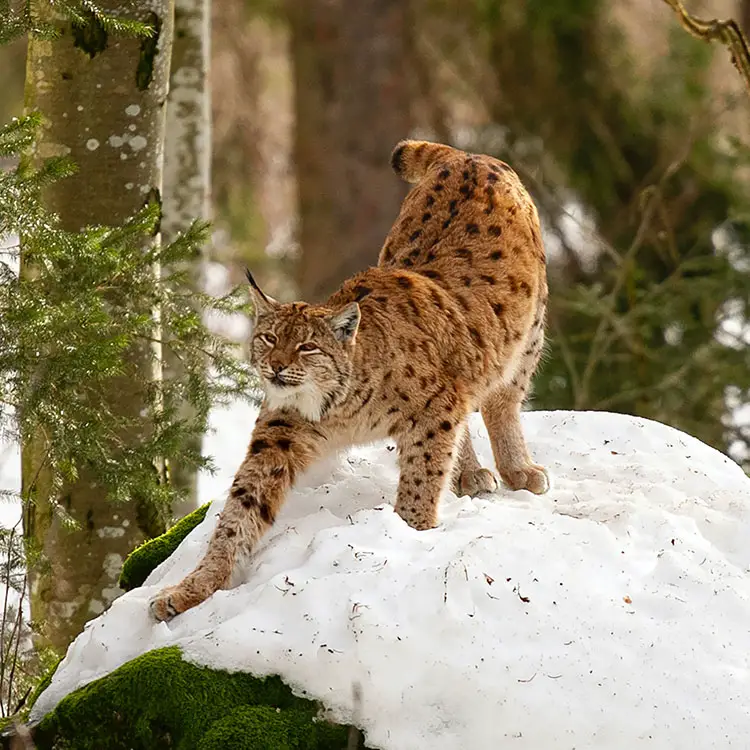
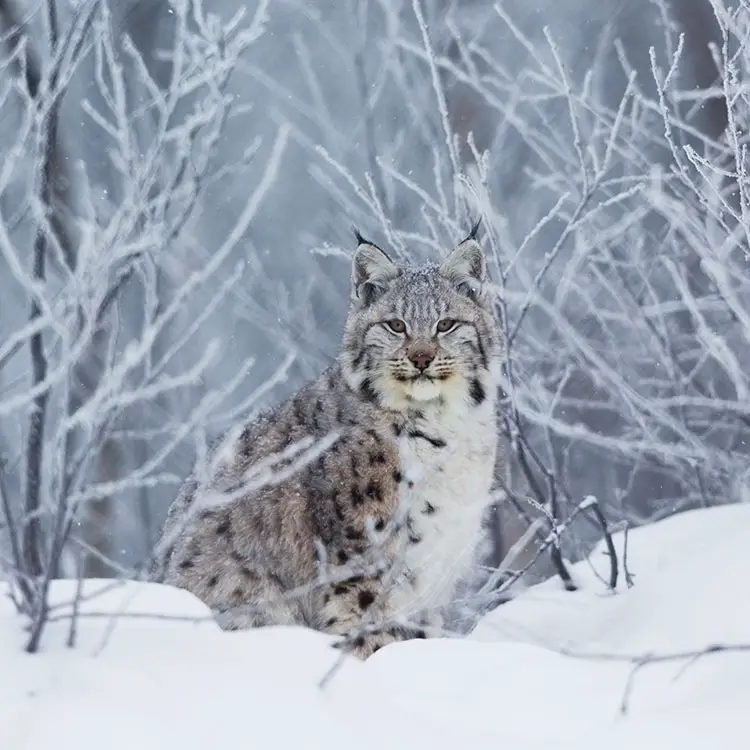
Left – Eurasian Lynx in Bayerischer Wald National Park, Germany | Unsplash: Gustavo Leighton & Right – Eurasian lynx in the snowy wilderness in Norway
Eurasian Lynx Facts
- Defining characteristics – Red or brown coat with stubby tail and tufts on ears
- Max size – 1.6m/5ft (including 25cm tail) & 36kg/80lbs
- Activity pattern – Active during the early morning/late evening
- Social behaviour – Solitary
- Habitat – Temperate and boreal forests
- Range – Mountainous regions of northern/eastern Europe and northern Asia
- Prey – Ungulates; deer, chamois, foxes, rabbits, hares & rodents
- Threats/Predators – Occasionally run into tigers, wolves and wolverines
- Conservation status – Least Concern
Iberian Lynx
Unfortunately, the same cannot be said for the distant cousin of the Eurasian lynx; the Iberian Lynx is one of the most threatened members of the cat family. This species is endemic to the Iberian peninsula and up until 2002 was on the verge of extinction. However, thanks to conservation effects, the population has risen from 94 to 855 in 2020 and their future is looking much brighter. Interestingly, the Iberian peninsula is also home to a critically endangered species of bear—the Cantabrian brown bear—and thankfully the Spanish government seems to be taking conservation seriously and there are reintroduction and protection programs in place for both species.
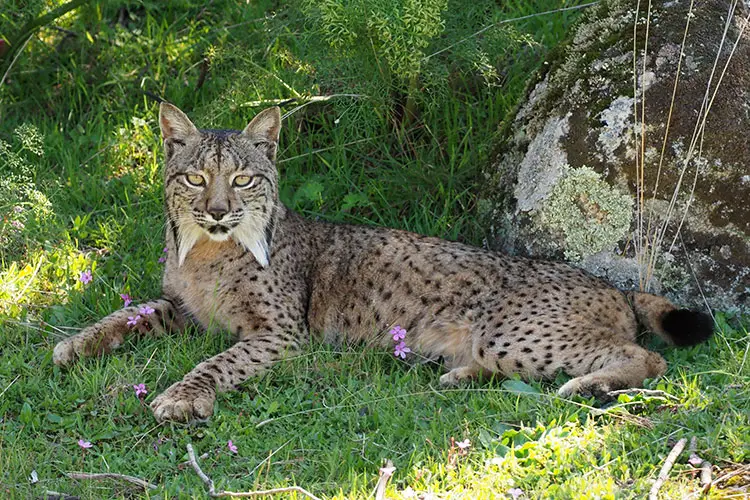
Iberian Lynx Facts
- Defining characteristics – Similar to the Eurasian Lynx but smaller
- Max size – 1m/3ft (including 16cm tail) & 16kg/35lbs
- Average Lifespan in the wild – 13 years
- Activity pattern – Nocturnal/crepuscular
- Social behaviour – Solitary
- Habitat – Mountainous terrain
- Range – Only a very small range in southern Spain
- Prey – Almost entirely the European rabbit
- Conservation status – Endangered (855 remain)
Canada Lynx
The Canada Lynx mainly occupies the boreal forests of Canada, Alaska and some of the northern states of the contiguous US. In terms of its evolutionary path, it is one divergence removed from the Eurasian and Iberian lynx, which makes sense due to their difference in habitat. They are typically very similar in colour to their European counterparts but have been known to also exhibit a blue/grey fur instead.
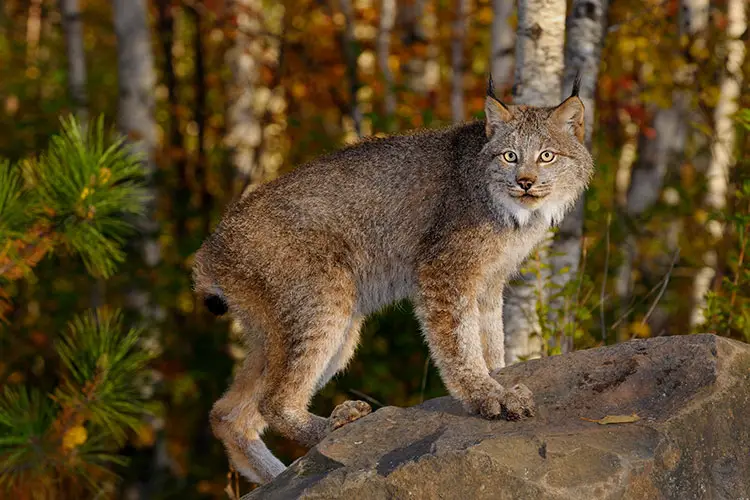
The Canada lynx feeds almost exclusively on the snowshoe hare and has developed long hind legs and huge paws which help it hunt in the snow. Consequently, areas with large populations of snowshoe hares like the Yukon will be your best bet to spot one in the wild.
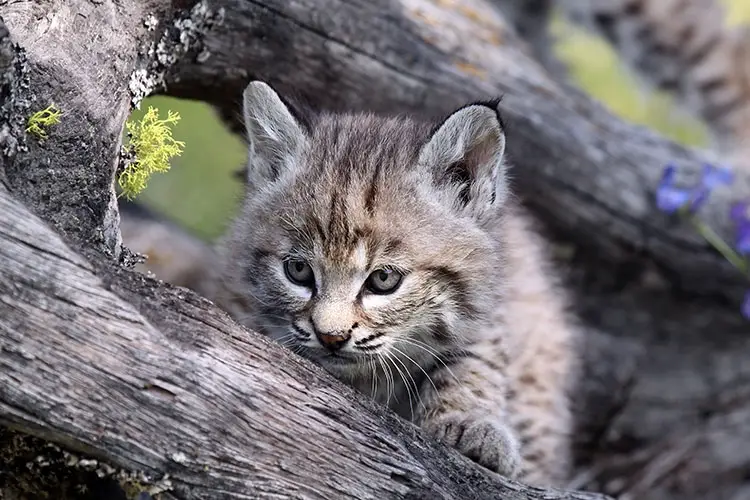
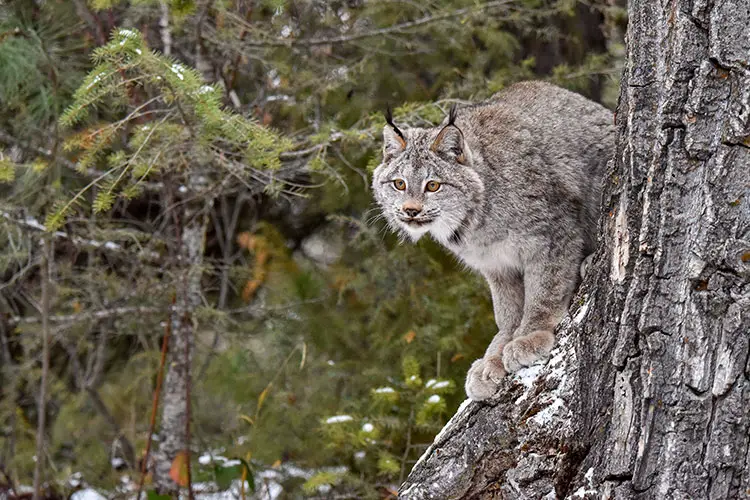
Left – Canadian lynx kitten | Right – Canada Lynx camouflaged into its environment
Canada Lynx Facts
- Defining characteristics – Often more greyish in colour with a brown tinge
- Max size – 1.2m/3.8ft (including 13cm tail) & 17kg/37lbs
- Average Lifespan in the wild – 14 years
- Activity pattern – Nocturnal/crepuscular but does hunt in the day
- Social behaviour – Solitary
- Habitat – Boreal forests
- Range – Canada, Alaska and small parts of the contiguous US
- Prey – Almost entirely the snowshoe hare
- Threats/Predators – Wolves and bears will eat kittens
- Conservation status – Least Concern
Bobcat
Bobcats occupy the southernmost range of all lynx species with their habitat stretching as far south as Mexico. They are also the smallest species of the lynx genus with males weighing no more than around 15kg/33lbs. Their coat also varies from a reddish-brown to grey with darker spots and streaks distributed throughout the coat for camouflage. Much like its northern cousin, the bobcat survives largely on rabbits and hares but is also known to hunt larger prey such as small deer. Bobcats venture as far south as Mexico and as far north as Canada, often overlapping territory with the Canada Lynx.
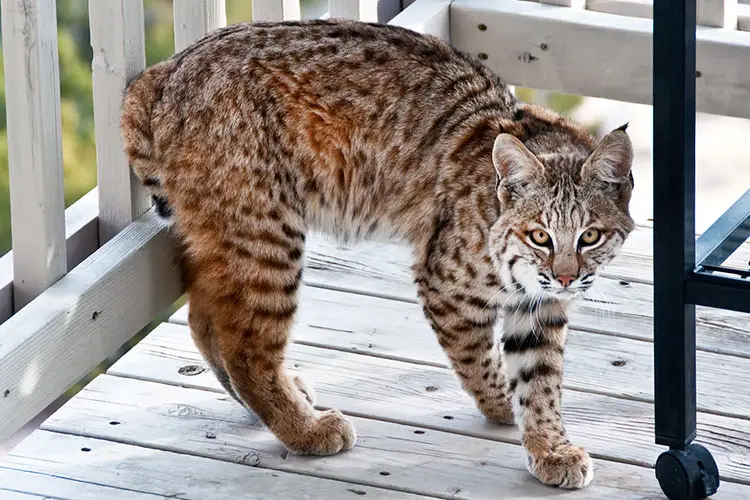
Bobcat Facts
- Defining characteristics – Tan/grey with spots and looks like it’s wearing eyeliner!
- Max size – 1.4m/4.5ft (including 20cm tail) & 15kg/33lb
- Average Lifespan in the wild – 12 years
- Activity pattern – Nocturnal but can be active in the day
- Social behaviour – Solitary and territorial
- Habitat – Woodlands, forests, mountainous terrain
- Range – Contiguous US, Southern Canada & Mexico
- Prey – Rodents, rabbits, deer, birds and reptiles
- Threats/Predators – Coyotes & domestic dogs (owls will swipe kittens)
- Conservation status – Least Concern
Puma Lineage | Puma, Herpailurus & Acinonyx Genera | 3 Species
The puma lineage is one of the most interesting for its variation of physical characteristics. Unlike the lynx lineage for example, where all species are very similar, the Jaguarundi, Cougar & Cheetah are all very different cats. Physically, the Jaguarundi is more akin to a large weasel! The Cougar is also relatively short and stocky, especially in comparison to the cheetah, which is long and slender and the fastest animal on earth. Honestly, out of all of the feline lineages, this is the most confusing to me!
Cougar
The cougar is one of the most famous of the cat species, it is well known in North American pop culture for being the largest cat species in the USA and Canada—second only to the Jaguar in the Americas. In fact, the cougar is actually the fourth largest cat in the world but is not part of the “big 5”, which as we know, are contained in the Panthera genus.
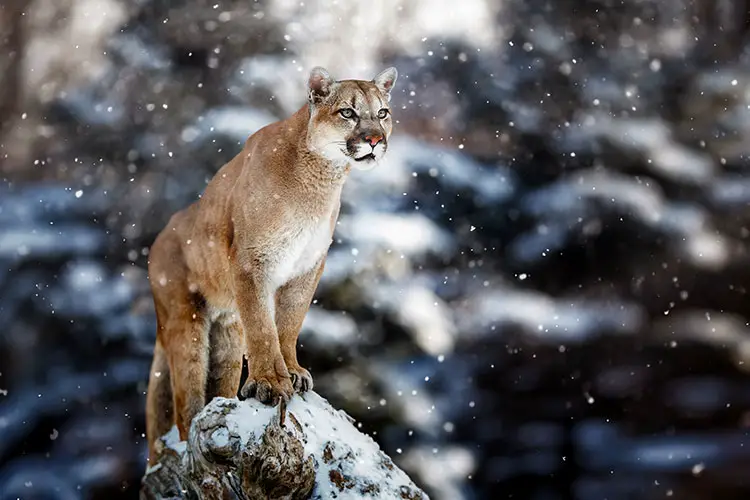
It has a gigantic range from northern Canada all the way down to southern Argentina and Brazil. Physically, the cougar is a stocky and powerful animal capable of taking down large mammals such as deer. Cougars occupy an awkward position in the food chain; they have the power to kill coyotes and wolves and as such their cubs are often preyed upon by these animals for self preservation. Cougars exhibit a reddish-brown fur without any camouflaging.
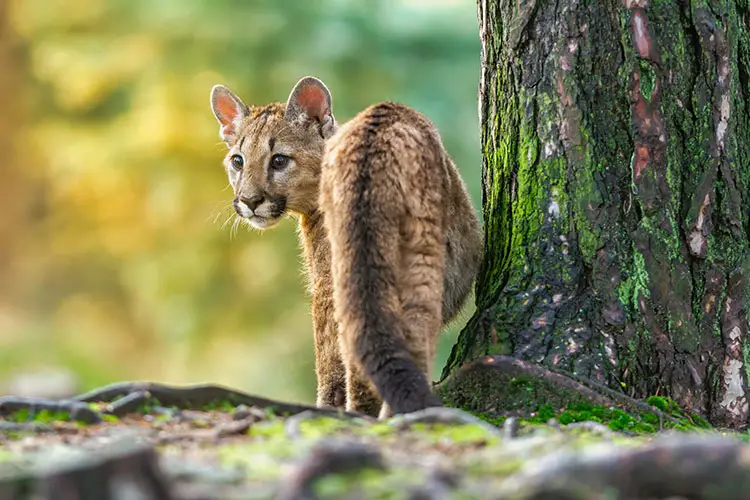
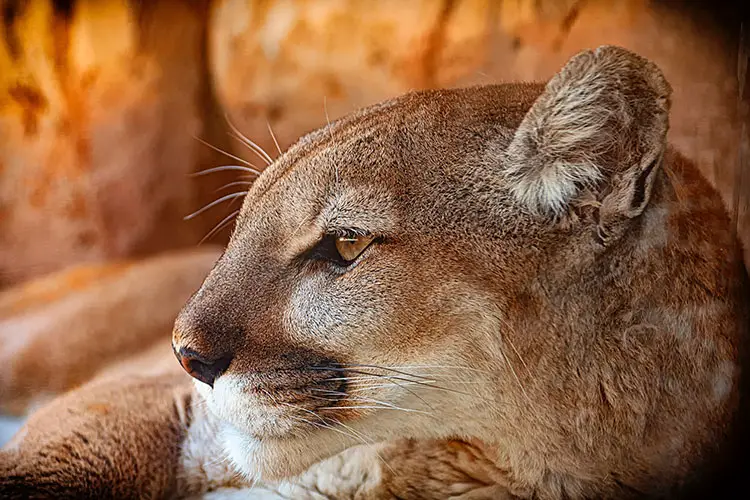
Left – Juvenile cougar & Right – Cougar in Turtle Back Zoo, USA | Unsplash: Robert Thiemann
Cougar Facts
- Defining characteristics – Reddish-brown coat with slender powerful build
- Max size – 2.75m/9ft (including tail) & 95kg/211lbs
- Average Lifespan in the wild – 18-20 years
- Activity pattern – Primarily nocturnal
- Social behaviour – Solitary but not uncommon to see in small groups
- Habitat – All types of forest, desserts and mountainous terrain
- Range – Occupies most of the Americas from Canada to Argentina
- Prey – Deer, caribou, elk, rabbits, birds, coyotes…
- Threats/Predators – Wolves, bears and others will prey on cubs
- Conservation status – Least Concern
Jaguarundi
The jaguarundi occupies a similar range to the cougar up to the Mexican/US border where it extends no further. Their fur can either be a deep reddish-brown or a dark grey. Weighing a maximum 7kg/15.5lbs, jaguarundis are much smaller than a cougars and would probably fit somewhere between a margay and an ocelot. It has short legs and a long body and tail, hence my previous comparison to weasels! Although they have been known to climb, they hunt mainly on the ground and are also known to be good swimmers. Thankfully, this loveable feline’s conservation status is also listed as of least concern.
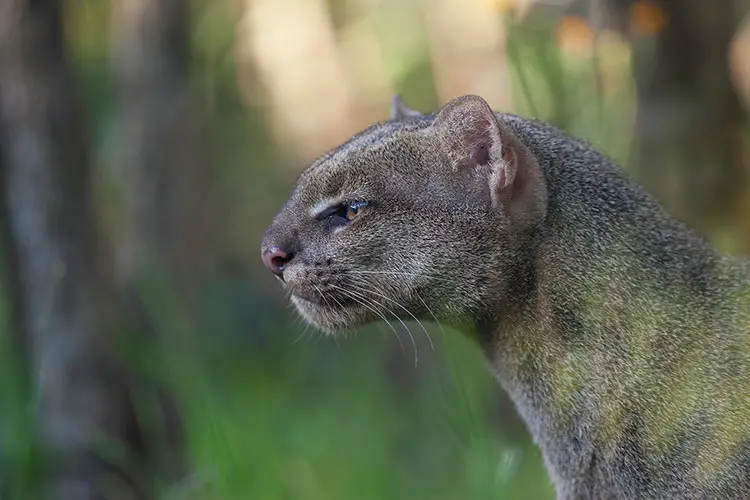
Jaguarundi Facts
- Defining characteristics – Looks like a large weasel!
- Max size – 1.4m/3ft (including 60cm tail) & 7kg/15.5lbs
- Activity pattern – Diurnal, hunting during the day and evening
- Social behaviour – Solitary but have been known to form pairs
- Habitat – Different types of forest, shrubland and desert
- Range – Central and South America
- Prey – Small mammals, birds, reptiles, fish etc..
- Threats/Predators – Cougars, large snakes, domestic dogs
- Conservation status – Least Concern
Cheetah
The cheetah is the fastest animal in the world with recorded speeds of up to 71mph/114kph. Cheetahs are split into four subspecies, three of which are found in Africa and the remaining Asian population is located in Iran. While these cats have long limbs to help propel them in their predatory chase, their maximum average weight is around 54kg/119lbs making them around half the weight of a leopard.
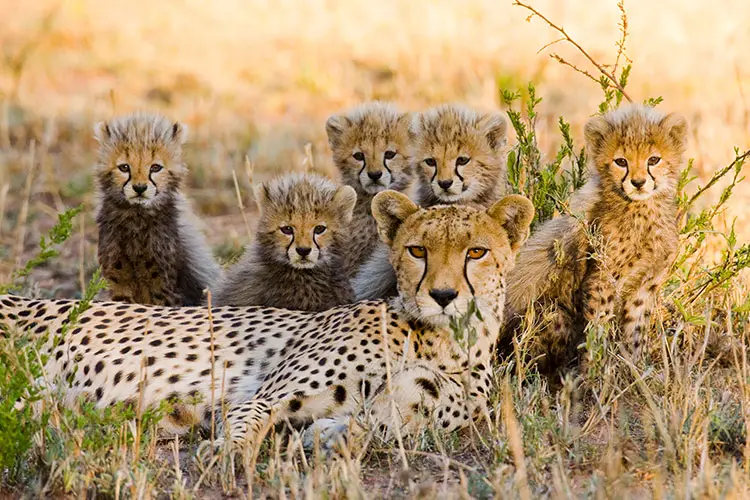
A cheetah’s diet is made up of small mammals such as antelope, warthogs, rabbits and birds. Because of their size, prey is often poached from cheetahs by the larger animals of the savannah such as lions and hyenas. Their fur is a light yellow-brown covered with black spots with their long bushy tails exhibiting stripes towards the end.
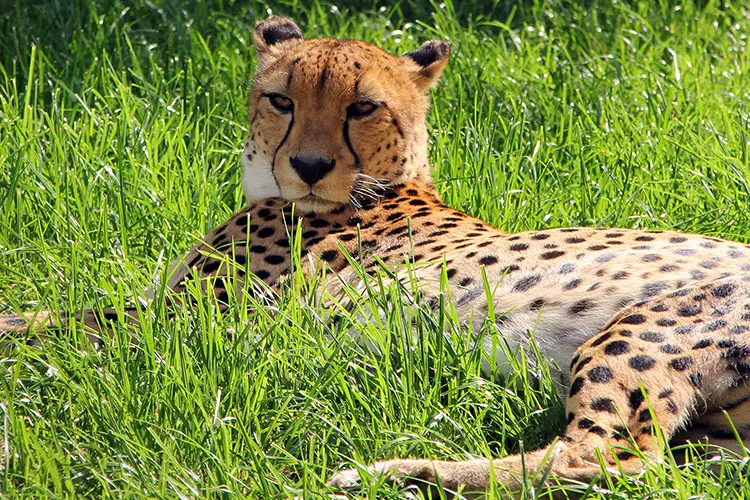
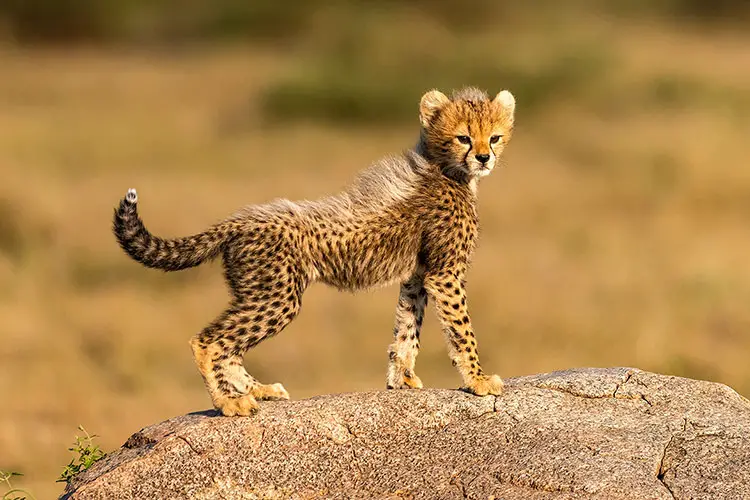
Left – Male Asiatic cheetah & Right – Cheetah cub in Serengeti National Park, Tanzania
Cheetah Facts
- Defining characteristics – Long, slender bodies for running super fast
- Max size – 2.3m/5ft (including 80cm tail) & 72kg/159lbs
- Average Lifespan in the wild – 8 years
- Activity pattern – Diurnal (to avoid lions and jaguars who hunt at night)
- Social behaviour – Can be both solitary and found in groups
- Habitat – Savannahs & mountain ranges surrounding deserts
- Range – Mostly Africa with a small population in Iran
- Prey – Primarily medium-sized ungulates such as gazelles and impalas
- Threats/Predators – Lions, leopards & hyenas
- Conservation status – Vulnerable (7,100 remain)
Leopard Cat Lineage | Prionailurus & Otocolobus Genera | 6 Species
The members of the leopard cat lineage are a group of small to medium-sized cats found throughout Asia. The two genera that make up this lineage diverged around 6.2 million years ago, making them the second-youngest felid lineage. The Otocolobus genera holds only one species: the Pallas’s cat—also known as the manul. The Prionailurus genera holds the remaining 5 species. Most of these cats are around the same size as a domestic cat and some—but not all—are adept at swimming and fishing.
Leopard Cat
The leopard cat is found throughout most of south, southeast and east Asia. Around the same size as a domestic cat, it is said to be the first species of cat to be domesticated in China. There are many different subspecies of leopard cat and their appearance varies from region to region; Tsushima leopard cats—who live in Japan—have longer, bushier hair compared to their Indonesian cousins who have a much shorter pelage with a darker, more defined colouration. They are both excellent swimmers and climbers and, being semi-arboreal, like to ambush small mammals, rodents and other animals from the cover of their forested habitat.
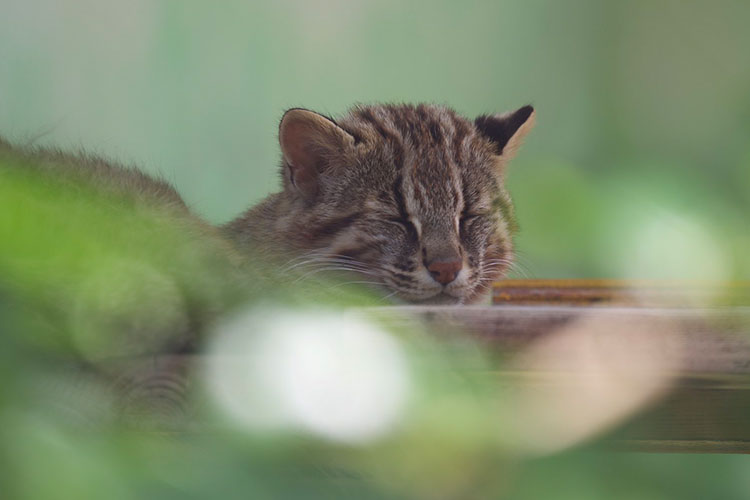
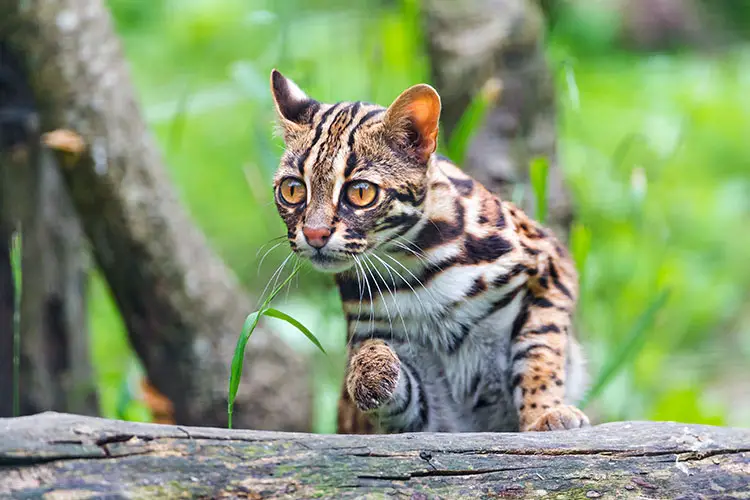
Left – Tsushima Leopard Cat | Flickr: S.Brickman & Right – Indonesian Leopard Cat | Flickr: Tambako The Jaguar
Sunda Leopard Cat
The Sunda leopard cat was initially thought to be a subspecies of the aforementioned leopard cat but recently in 2017, genetic analysis showed it to be a separate species altogether. While the leopard cat occupies main-land Asia, the Sunda leopard cat is found in the island nations of Indonesia and the Philippines. They thrive in tropical forests where they have been observed hunting mice, rats, other rodents, lizards and beetles mostly at night.
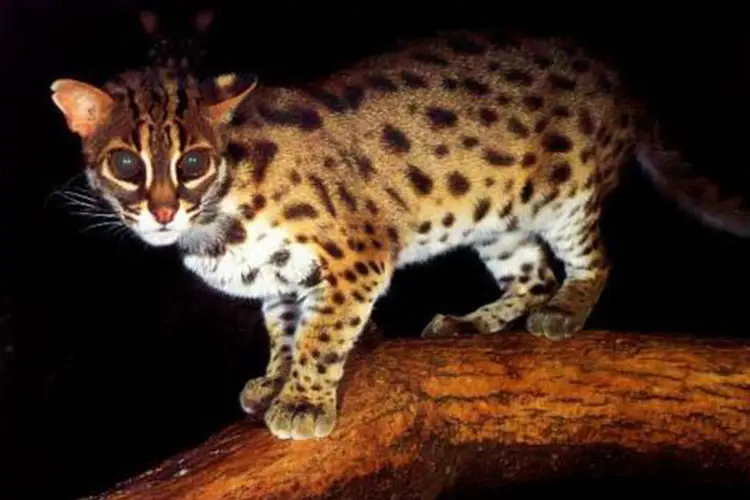
Leopard Cat & Sunda Leopard Cat Facts
- Defining characteristics – Bands on its head/neck and rosettes/spots on its body
- Max size – 1m/3ft (including 30cm tail) & 7kg/16lbs
- Average Lifespan in the wild – 4 years
- Activity pattern – Nocturnal but can be sighted during the day
- Social behaviour – Solitary
- Habitat – Forests, shrubland and grassland
- Range – South, southeast and east Asia
- Prey – Birds, small mammals, rodents, fish etc..
- Threats/Predators – Birds of prey, larger cats & humans
- Conservation status – Least Concern
Fishing Cat
A close relative to the leopard cat, the fishing cat is found in the wetlands of south and Southeast Asia; its known populations are dotted around the coast of the Bay of Bengal with small populations found inland towards the Himalayas and west India. As their name and habitat would suggest, this medium-sized feline is extremely adept at swimming and lives primarily on a diet of fish. They have webbed paws to aid with swimming although less so than the leopard cat.
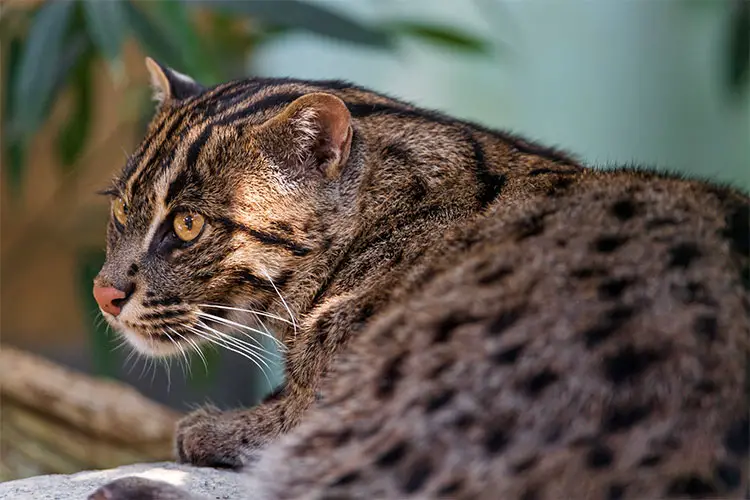
Fishing Cat Facts
- Defining characteristics – Stocky build & webbed paws for fishing
- Max size – 1.1m / 3ft (including 30cm tail) & 12kg / 26lbs
- Average Lifespan in the wild – Unknown (12 years in captivity)
- Activity pattern – Nocturnal
- Social behaviour – Solitary
- Habitat – Wetlands, swamps, mangroves, lakes etc…
- Range – South and southeast Asia
- Prey – Mostly fish but also hunts birds, rodents, insects, reptiles etc…
- Threats/Predators – Humans (habitat destruction)
- Conservation status – Endangered
Flat-Headed Cat
Like the fishing cat, the flat-headed cat inhabits wetland areas and eats large amounts of fish. They are found on the islands of Borneo and Sumatra and the Malay Peninsular. Around the size of a domestic cat, flat-headed cats are smaller than most of the other cats in their lineage and are particularly rare. They have similar vocalizations to that of a domestic cat and are known to purr! They hunt mainly at night and will drag their aquatic prey away from the water to prevent it from escaping.
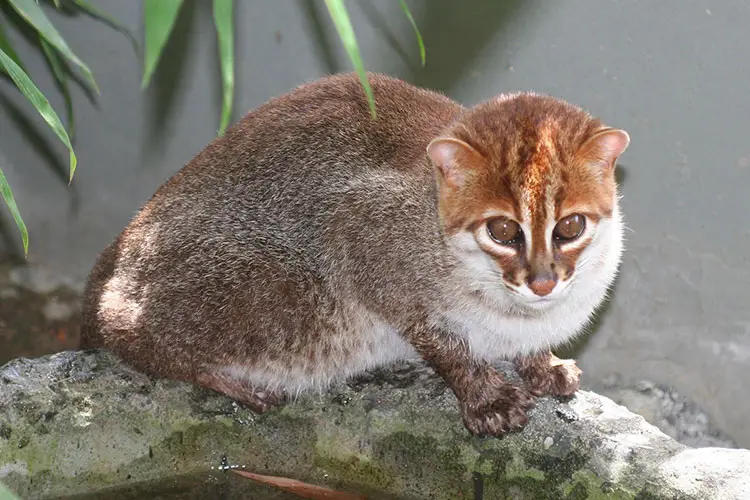
Flat Headed Cat Facts
- Defining characteristics – Mainly brown with white underbelly & red facial pelage
- Max size – 70cm (including 20cm tail) & 2.5kg/6lbs
- Average Lifespan in the wild – Unknown (14 years in captivity)
- Activity pattern – Mostly nocturnal but have been found to be crepuscular
- Social behaviour – Solitary
- Habitat – Tropical forests and freshwater wetlands
- Range – Borneo, Sumatra & the Malay Peninsular
- Prey – Fish, amphibians, mammals
- Threats/Predators – Humans (habitat destruction)
- Conservation status – Endangered (less that 2,500 remain)
Rusty-Spotted Cat
The rusty-spotted cat is one of the smallest cats in the world, rivalled by Africa’s black-footed cat; they weigh up to 1.6 kg, which is around half the size of a domestic cat. They are found mainly in the forests and grasslands of India and Sri Lanka but have also been found to exist in Nepal. Rusty-spotted cats have been known to climb trees but they are certainly not arboreal and spend most of their time hunting small mammals and birds on the ground.
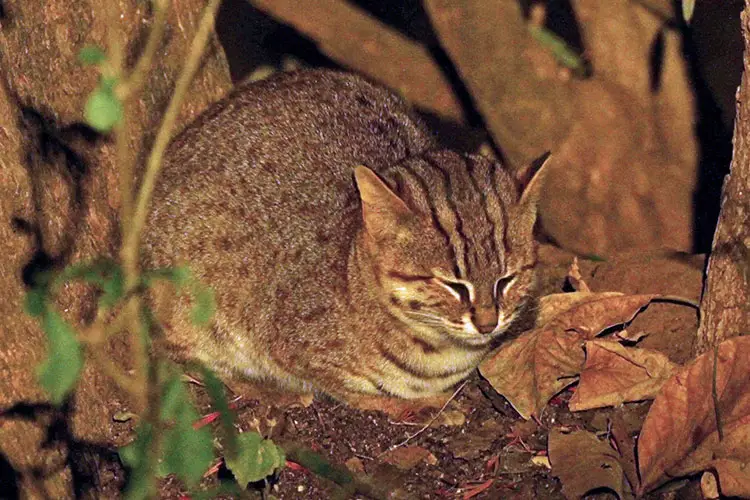
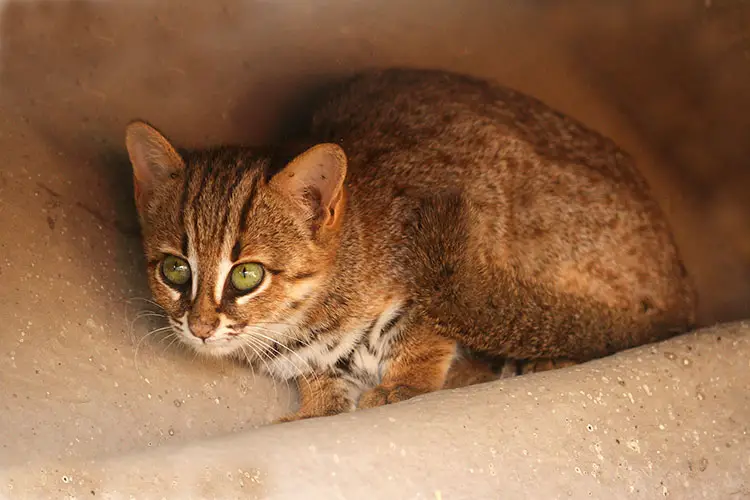
Left – Rusty Spotted Cat napping! | WikiCommons: Davidvraju & Right – Rusty Spotted Cat awake! | WikiCommons: Davidvraju
Rusty-spotted Cat Facts
- Defining characteristics – One of the smallest cats in the world
- Max size – 80cm / 30in (including 30cm tail) & 1.6kg / 3.5lbs
- Average Lifespan in the wild – Unknown (up to 18 years in captivity)
- Activity pattern – Nocturnal or crepuscular
- Social behaviour – Solitary
- Habitat – Both temperate and tropical forest
- Range – India, Nepal and Sri Lanka
- Prey – Birds, small mammals, seeds, grains & fruit
- Threats/Predators – No known predators (probably because it’s so small!)
- Conservation status – Near Threatened
Pallas’s Cat
This is by far my favourite cat species; somehow natural selection has chosen one of their defining characteristics to be an intensely grumpy stare! Look!
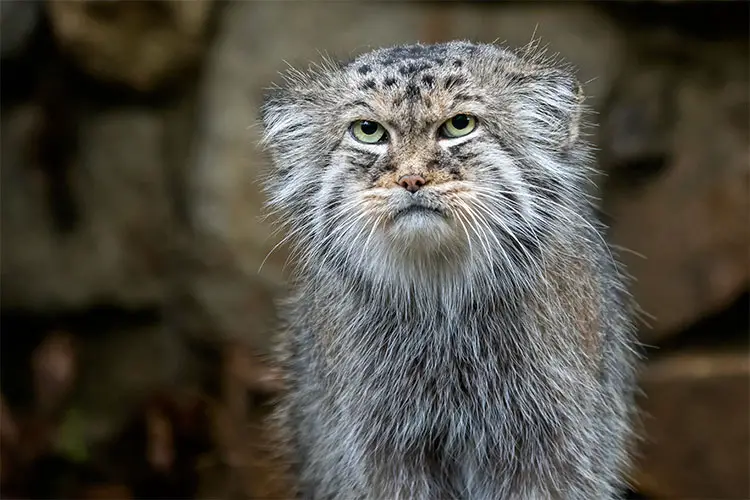
The Pallas’s cat is named after Peter Simon Pallas, a Prussian zoologist who first encountered the manul in 1776 around Russia’s Lake Baikal. Similar in appearance to the Pampas Cat—found in South America—they exhibit thick fur and a bushy tail, which equip it well for the high mountainous regions of Asia in which they abide. They live solely in mountainous steppes and rocky areas where they hunt picas and other small mammals.
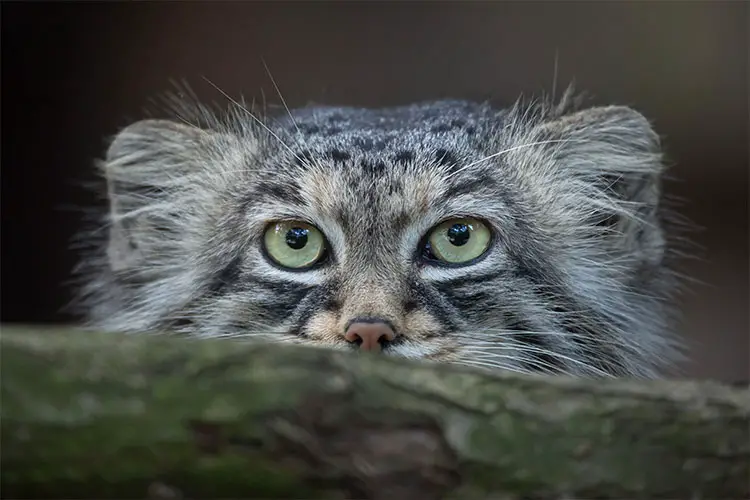

Left – Adult Pallas’s Cat peering over a tree branch & Right – Pallas’s Cat kitten & mother
Pallas’s Cat Facts
- Defining characteristics – Long, shaggy grey hair and very grumpy looking!
- Max size – 90cm / 35 in (including 30cm tail) & 5kg / 11lbs
- Average Lifespan in the wild –
- Activity pattern – Nocturnal
- Social behaviour – Solitary
- Habitat – Mountainous terrain
- Range – Central and east Asia & the Middle East
- Prey – Pikas, other small mammals
- Threats/Predators – Herding dogs & humans
- Conservation status – Least Concern
Domestic Cat Lineage | Felis Genera | 6 Species (+ Domestic Cat)
Felis—the sole genera in the domestic cat lineage—split from the leopard cat lineage somewhere between 3.04 to 0.99 million years ago. It contains 6 species, all of which are small to medium-sized cats found in Eurasia. Visually, they are the most similar to domestic cats, with only the black-footed cat having significant markings on its fur. Much like our beloved domestic cats, they prey predominantly on small mammals and birds although they are not likely to leave these on anyone’s doorstep!
Jungle Cat
The jungle cat is the largest felid in the domestic cat lineage, weighing up to 16kg / 35lbs. Although it is named as such, the jungle biome actually makes up very little of the jungle cat’s territory; they are more often found in grasslands, deciduous forests, mountainous terrain and wetlands—hence its nickname, the swamp cat. It is found throughout much of the Middle East and Asia where it preys on small mammals, birds and fish. There is some debate as to how many subspecies exist, with as few as 3 and as many as 10 recognised depending on the governing body.
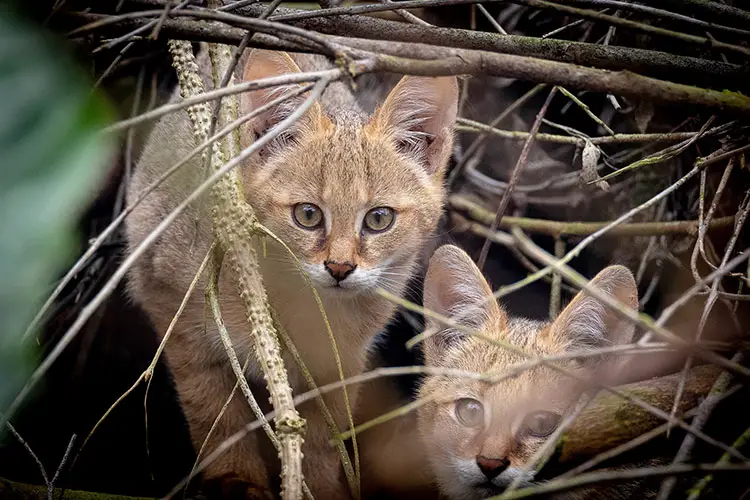
Jungle Cat Facts
- Defining characteristics – Greyish fur with two distinct black stripes on its front legs
- Max size – 1.6m / 63in (including 40cm tail) & 16kg / 35 lbs
- Average Lifespan in the wild – 13 years
- Activity pattern – Have known to be both nocturnal or diurnal
- Social behaviour – Solitary
- Habitat – Wide range including wetlands, mountains, grasslands & forests
- Range – The Middle East, central, south & southeast Asia
- Prey – Small prey including birds, fish, rodents and other small mammals
- Threats/Predators – Larger cats, snakes and humans
- Conservation status – Least Concern
Black-Footed Cat
The black-footed cat is the smallest feline in the domestic cat lineage and one of the smallest species in the world. They are found exclusively in southern Africa in the countries of Namibia, Botswana and South Africa. I like to think of them as Africa’s answer to the KodKod! They have a light brown coat with clear black markings and, unlike the Kodkod, have a strip of black fur under their feet—hence the name. They spend the day relaxing in the burrows of other animals and spend the night hunting for small animals including mammals, birds, reptiles and amphibians.
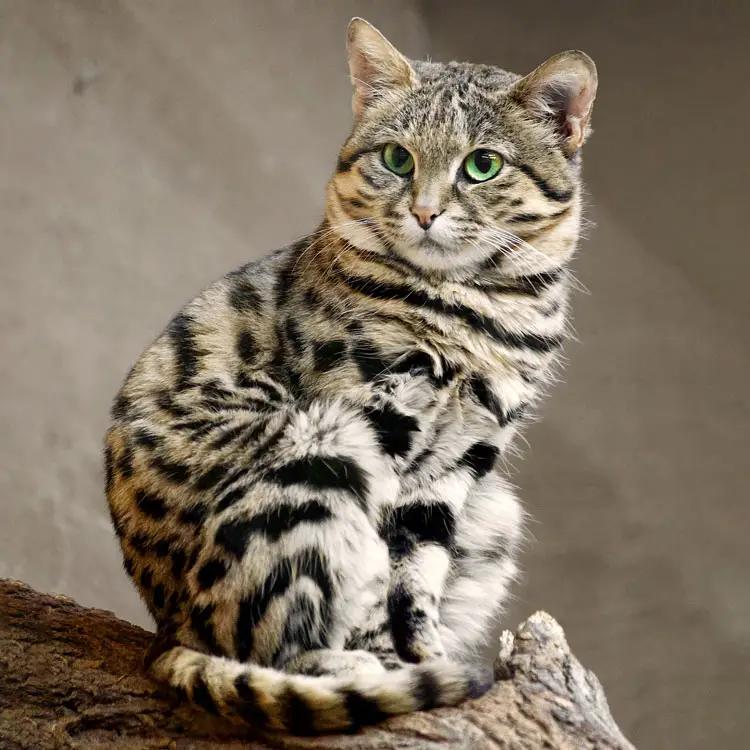
Black-Footed Cat
- Defining characteristics – Very small with clear black spots and strips
- Max size – 70cm / 26.5 in (including 20cm tail) & 2.5 kg / 5.5 lbs
- Average Lifespan in the wild –
- Activity pattern – Nocturnal
- Social behaviour – Solitary
- Habitat – Grasslands and deserts
- Range – Southern Africa
- Prey – Birds, small mammals, amphibians & reptiles
- Threats/Predators – Humans due to poaching
- Conservation status – Vulnerable
Sand Cat
The sand cat is a desert specialist; they are found throughout the western half of the Sahara desert and dotted around the Middle East and Central Asia. They are famous for hunting snakes, in particular, the highly venomous members of the viper family (not all heroes wear capes!). Sand cats are excellent diggers and spend most of the day escaping the desert heat in burrows. They hunt during the night and use their digging skills to prey upon animals such as the sandfish—a species of skink known to burrow or “swim” in the sand. Like the jungle cat, the sand cat also has two black stripes on its front legs.
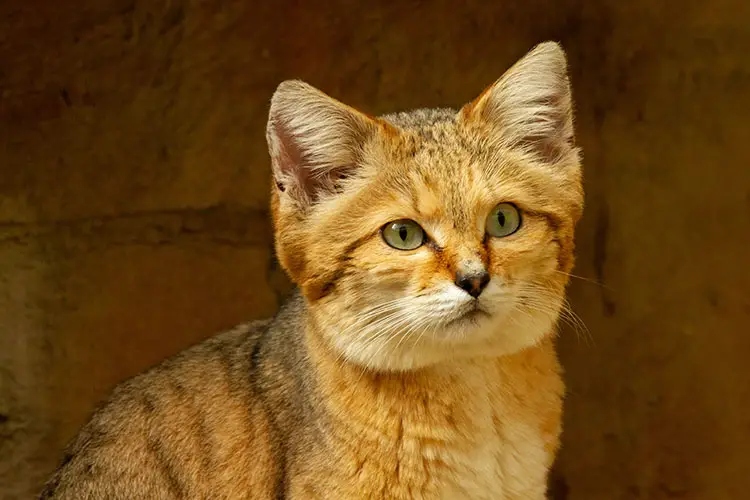
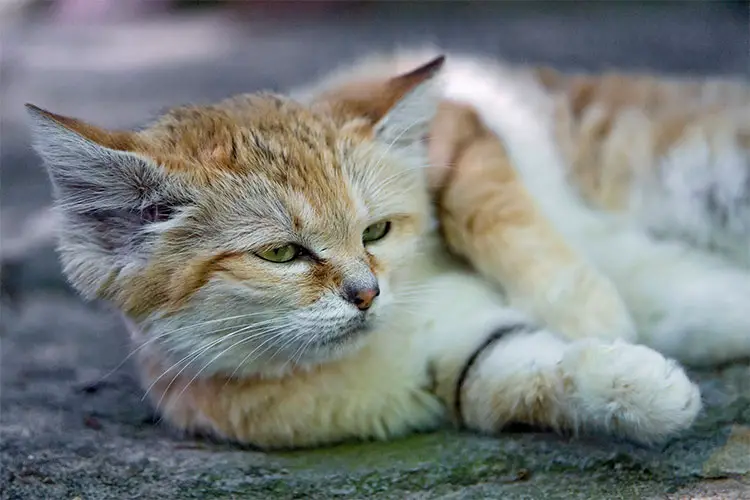
Left – Sand cat portrait | Pixabay: Bailey73 & Right – Sand cat resting | Flickr: Tambako The Jaguar
Sand Cat Facts
- Defining characteristics – A small, fluffy version of the jungle cat!
- Max size – 80cm / 22in (including 30cm tail) & 3.4kg / 7.5lbs
- Average Lifespan in the wild – Unknown (13 years in captivity)
- Activity pattern – Nocturnal
- Social behaviour – Solitary
- Habitat – Various desert-like ecosystems
- Range – Sahara, Arabian Peninsula & Central Asia
- Prey – Small mammals, birds, reptiles (including snakes!) & invertebrates
- Threats/Predators – Snakes, jackals and owls
- Conservation status – Least Concern
Chinese Desert Cat
Much like the jungle cat who does not frequent the jungle, the Chinese desert cat does not live in the desert! Also known as the Chinese mountain cat (which is much more accurate!) they are found in the alpine meadows and high altitude grasslands of northern China. They are one of the rarest cats in the world and many of their characteristics and behaviour traits that are still unknown. Like many other cats of this lineage, they spend the day relaxing in burrows and hunt mainly during twilight or at night, preying upon birds and small mammals such as the pika.
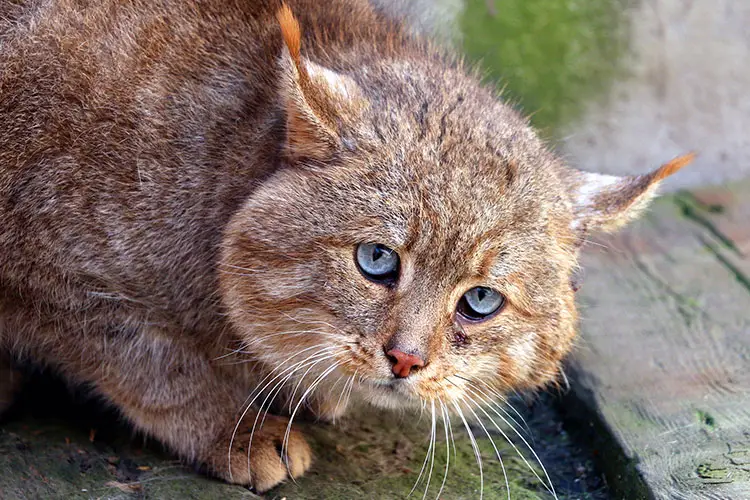
Chinese Desert Cat Facts
- Defining characteristics – Thick greyish fur with a black-striped tail
- Max size – 125cm / 50in (including 40cm tail) & 9 kg / 20 lbs
- Average Lifespan in the wild – Unknown
- Activity pattern – Nocturnal or crepuscular
- Social behaviour – Solitary
- Habitat – Alpine tundra & mountainous steppe (grassland)
- Range – Endemic to northern China
- Prey – Small mammals such as pikas, rodents and birds
- Threats/Predators – Wolves and bears will take their young
- Conservation status – Vulnerable (one of the world’s rarest wild cats)
African Wild Cat
The African wild cat is the closest relative to the Chinese desert cat, both of which are two divergences removed from the domestic cat. They have a huge range covering the Middle East, central and southern Asia and most of Africa. They occupy a variety of biomes from the tropical grasslands of Africa—also known as savannah—to the steppes and mountain ranges of central and southern Asia. They prey mostly on small mammals such as mice and rats, birds, small reptiles and even insects. There are three known subspecies of African wildcat: the nominate subspecies—a subspecies given the same name as the species to which it belongs—occupies northern and central Africa, the Southern African wildcat and the Asiatic wildcat.
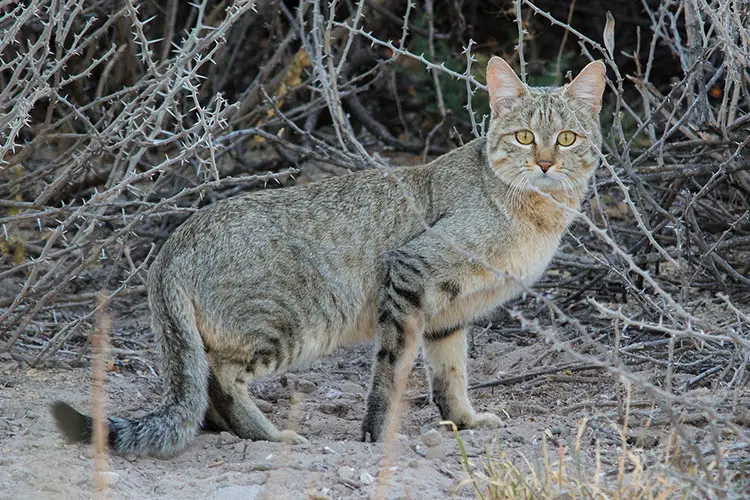
African Wildcat Facts
- Defining characteristics – Sandy-grey fur with black markings on legs and tail
- Max size – 95cm / 37in (including 35cm tail) & 4.5kg / 10lbs
- Average Lifespan in the wild – 15 years
- Activity pattern – Nocturnal
- Social behaviour – Solitary
- Habitat – Mountains, deserts & grasslands
- Range – Africa, the Middle East & south and central Asia
- Prey – Mice, rats, birds, reptiles and insects
- Threats/Predators – Foxes, wolves, larger cats & birds of prey
- Conservation status – Least Concern
European Wild Cat
Coming from the same group of wildcats as the African wild cat, the European wild cat is similar in appearance but noticeably more bushy and with less distinct markings. They are the closest relative to the domestic cat and, in addition to Scotland, are found throughout much of the central and southern regions of mainland Europe—as far east as Turkey and as far west as Portugal. They live in deciduous forests where they prey upon small mammals such as rats, voles & mice and many other animals including birds and reptiles. There are two known subspecies, which separate those found in Turkey and the Caucasus region from those found throughout the rest of Europe.
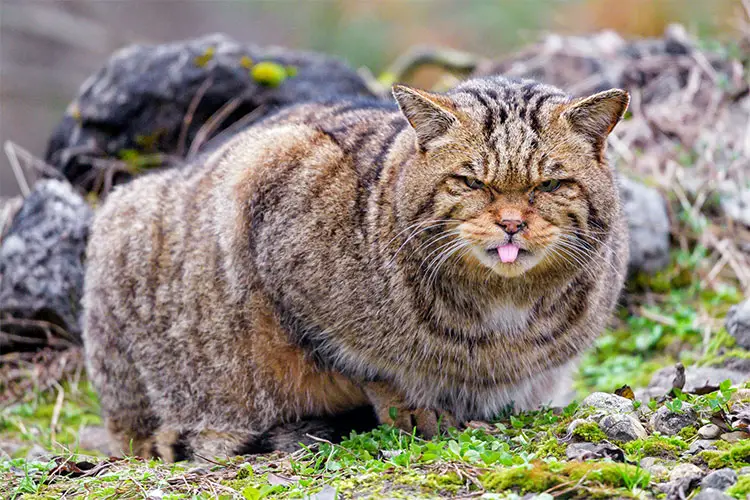
European Wild Cat Facts
- Defining characteristics – Very similar to a domestic cat
- Max size – 100cm / 29.5in (including a 35cm tail)
- Average Lifespan in the wild – 15 years
- Activity pattern – Mostly nocturnal but will hunt in the daytime
- Social behaviour – Solitary
- Habitat – Deciduous forest
- Range – Europe (with the exception of Northern Europe)
- Prey – Small mammals, birds and reptiles
- Threats/Predators – Foxes, wolves, larger cats & birds of prey
- Conservation status – Least Concern
